
























Communities across Canada are readying displays of dark blue and purple lights for Light It Up! for NDEAM, an annual celebration for National Disability Employment Awareness Month.
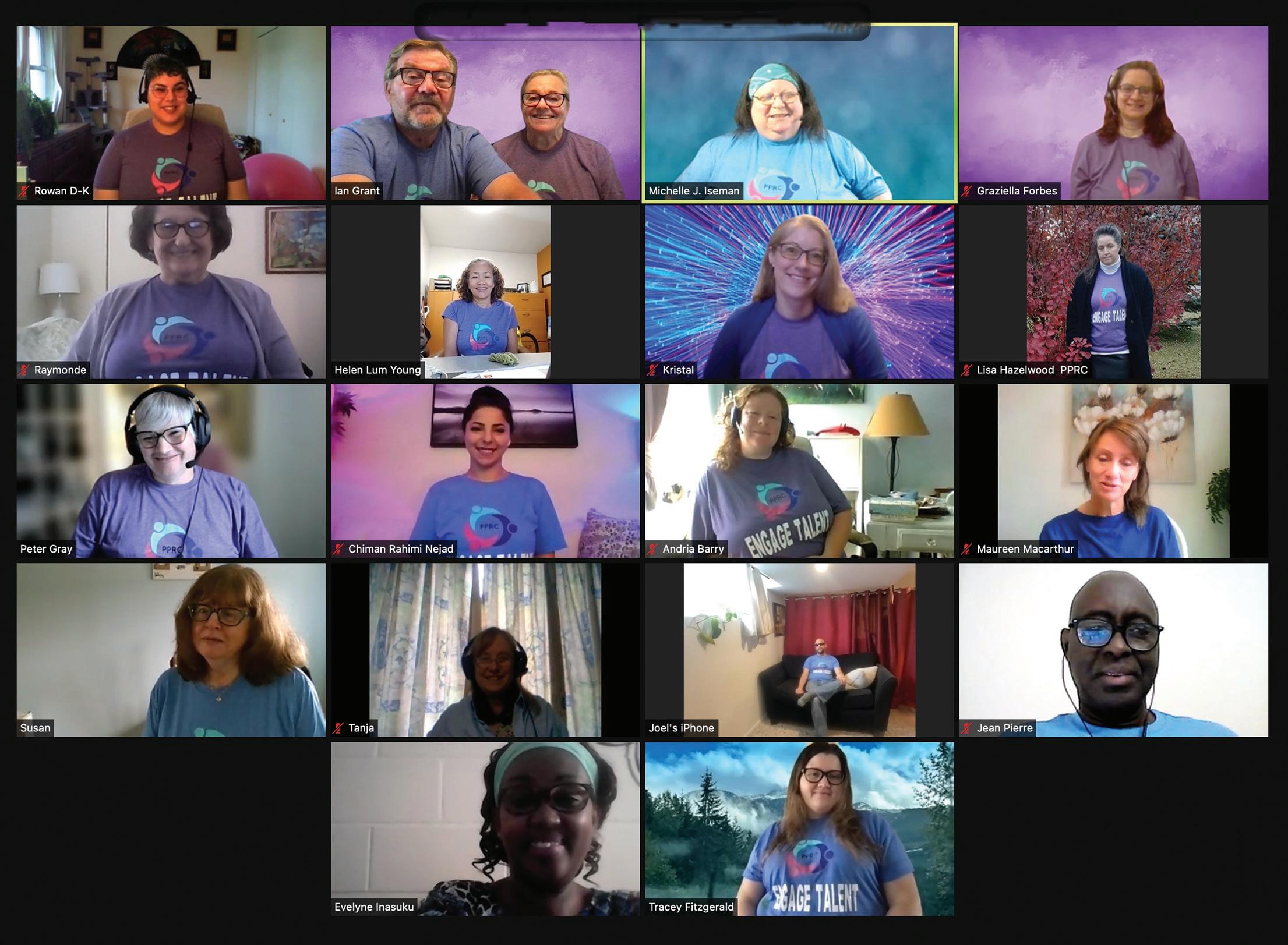
The colourful displays are intended to cast a spotlight on the many ways persons living with disabilities contribute to businesses and help companies be successful and competitive, says Linda Simpson, Director of Rehabilitation Services at Performance Plus Rehabilitative Care Inc. (PPRC). PPRC’s participation in 2021 helped ignite nationwide awareness and conversation about the important business benefits of disability inclusion.
Now in its third year, the one-night event brings together dozens of sites across every province and two territories to illuminate structures such as bridges, commercial buildings, businesses, landmarks, airport control towers, city and town halls, libraries, museums, schools, homes, and municipal signs.
“The campaign promotes disability inclusion in employment,” says Simpson. “It’s important
that businesses get engaged and prioritize inclusion for enhancing their expertise and brands.”
The Oct. 20 event is significant for PPRC as they build on a 28-year track record of helping persons living with disabilities in securing sustainable work, as well as helping employers be more inclusive in their culture and recruiting practices.
NDEAM is a decades-old celebration in October that recognizes the many ways persons living with disabilities contribute to businesses and their communities.
Light It Up! For NDEAM was started in 2020 by the Ontario Disability Employment Network (ODEN) as part of its annual NDEAM campaign. The colour of lights is significant, with purple symbolizing creativity, harmony, and co-operation. Dark blue represents trust, dignity, authority, professionalism, intelligence, and loyalty.
In 2021, the event went national in collaboration with the Canadian Association for Supported Employment (CASE) and MentorAbility Canada, with more than 300 participating locations.
Jobs Ability Canada, the only national AI recruitment platform built by and for persons living with disabilities, has joined the 2022 campaign.
PPRC is one of the local coordinators for MentorAbility, matching job seekers living with disabilities to employers either to meet-up virtually or in-person for a half day or full day to learn more about their careers and work.
“Myths and stigmas abound, and employers might perceive that someone living with a disability can’t do a job,” says Simpson. “The truth is that many people with disabilities are welleducated, holding multiple degrees. If employers don’t tap into this talent pool, they will miss out on exceptional talent and the competition is going to get ahead.”
Sparking conversations and creating change Throughout October there will be opportunities to engage with Light It Up! For NDEAM on social media by using campaign hashtags such as #LightItUpForNDEAM, #NDEAM, and #EngageTalent. The campaign also encourages engaging with local politicians and media to highlight the importance of promoting disability inclusion in the workplace and beyond. Wearing blue and purple on Oct. 20 is another way to support the campaign.
A full list of participating locations is available at the ODEN’s website. Locally, the Ottawa sign in the Byward Market will be lit purple and blue.
Simpson notes employers who recruit from PPRC’s talent pool for ongoing or upcoming job competitions can access an array of support services. For more information and to get started, visit pprc.ca or call 613-748-3220.
It’s important that businesses get engaged and prioritize inclusion for enhancing their expertise and brands.





The Eastern Ontario Business Journal is a sister publication to the Ottawa Business Journal, building on that outlet’s 25-year history of covering business in the National Capital Region. For readers, EOBJ contains news and information about people and businesses from across Eastern Ontario. Our advertisers can explore the competitive advantages, market opportunities and major employers from across the region on the following pages.
PRESIDENT Michael Curran, 613-696-9491 publisher@obj.ca
Terry Tyo, 613-601-9734 terry@greatriver.ca

EDITOR IN CHIEF Anne Howland anne@obj.ca
General Inquiries, sales@obj.ca
CREATIVE DIRECTOR
Tanya Connolly-Holmes, 613-696-9487 creative@greatriver.ca



DESIGN DEPARTMENT
Celine Paquette, 613-696-9486 celine@greatriver.ca
Deborah Ekuma, 613-696-9493 deborah@greatriver.ca

FINANCE
Cheryl Schunk, 613-696-9490 cheryl@greatriver.ca
Great River Media, PO Box 91585 Ottawa, ON K1W 1K0 obj.ca
All content of Ottawa Business Journal is copyright 2021. Great River Media Inc. and may not be reproduced in any form without permission of the publisher. Publisher’s Liability for error: The Publisher shall not be liable for slight changes or typographical errors that do not lessen the value of an advertisement. The publisher’s liability for other errors or omissions in connection with any advertisement is strictly limited to publication of the advertisement in any subsequent issue or the refund of monies paid for the advertisement.
A guaranteed minimum of 20,000 copies are printed and distributed.
How wonderful to celebrate some of Eastern Ontario’s fastest-growing companies!
Somehow it seems even more wonderful as we disentangle ourselves from the unprecedented challenges of the past couple of years and find ourselves facing (not quite so unprecedented) issues around inflation, low unemployment and supply chain restrictions. It is impressive that our fastest-growing companies are experiencing such rapid rates of growth despite the turbulence we continue to cope with.
I must say, as I’ve taken up the reins of the Eastern Ontario Business Journal as editor, I’ve been amazed to learn about such a range of innovative and resilient businesses and entrepreneurs. From the smallest things, such as bespoke hats or a welcoming and inclusive café, to the giant logistics and manufacturing facilities of some of the world’s largest companies, it seems there is nothing that cannot take root and grow in our region.
If you’ve been following our coverage and listening to our EOBJ Podcasts, you know we’ve been talking about not only the incredibly tight labour market, but also the need for more housing and the necessity of accessible rural internet.
There are undoubtedly a host of other issues, especially as we look into a future that will almost certainly involve a fundamental shift from fossil fuels to other forms of power. A hot topic at the recent Ontario East Municipal Conference was electric vehicles and the ramifications that technology would have on our industries — including the agricultural sector.
Our local, provincial and federal governments have done much to support the region over many years, but that dialogue has to continue. We must bring our issues to the forefront and make our case for working together to the betterment of our communities.
FIND OUT MORE CONTACT US AT
423

Experience FALLS the of GRANDEST up to $100 DAILY ACTIVITY CREDIT when booking the Fall Escape Package




Not to mention the fabulous tourist attractions and delicious eats — my list of staycation activities has definitely expanded.
This is why it is no surprise that our top 10 fastest-growing companies are such a diverse bunch: a staffing agency, a wonton-maker, a luxury houseboat purveyor, a pyrotechnic company, a welding shop, to name a few. It’s truly testament to the ability of our region to attract and support a variety of businesses and set them on the track to success.
Of course, rapid growth brings its own challenges, many of which have been exacerbated in the current business environment — access to talent and other basic infrastructure springs to mind. We know there is work to be done to continue to develop and build Eastern Ontario into a hotbed for businesses of all stripes.
This is where I hope the Eastern Ontario Business Journal can help. We want to hear your stories and to learn about your ventures. And we want to highlight and discuss the issues that have the potential to limit your growth — or to expedite it.

My email is always open and I’m eager to keep learning about this vast region we call Eastern Ontario.
You can reach me at anne@obj.ca.
Anne Howland Editor in Chief
Off the travel radar for most of the pandemic, Kingston Airport is clearing the runway for traffic to resume in earnest after landing a $1.3-million federal grant.
The cash is part of a total $2.8-million package of non-repayable contributions from the federal government for airports in southeastern Ontario, including terminals in Kingston, Cornwall and Arnprior.
The Kingston Airport will receive $1.3 million to help it launch air service to Montreal via Pascan Aviation, which will begin twice-daily service to MontrealTrudeau International Airport on Sept. 21.
The funding will go toward assisting the carrier with costs like baggage-handling fees, signage and other expenses as well as hiring increased security and service staff at the terminal.
Airport manager Aron Winterstein said about 18,000 passengers are expected to use Pascan’s service by the end of the year, helping revive a facility that drew more than 75,000 travellers annually before the pandemic effectively grounded its operations.
The Kingston Airport was renovated in 2019 to expand the terminal and increase its number of passengers. But it lost its air connections when Air Canada halted its daily flights to Pearson International Airport the following March.
A small commuter carrier, FLYGTA Airlines, has operated eight flights a week from Kingston to Billy Bishop Toronto City Airport since February, but only about 200 passengers have used its eight-seater aircraft so far.
“It’s been really catastrophic,” Winterstein said of the pandemic’s impact on the airport. “COVID hit the tourism and the airline market especially hard, but it was even disproportionately so towards smaller airports like ours.”
Kingston Chamber of Commerce CEO Karen Cross called the resumption of air service a “godsend” for the city’s business community.
“It’s multi-faceted, the number of businesses that this is going to support,” she said.
Winterstein said the airport projects passenger traffic will reach about 50 per cent of pre-pandemic levels by next summer, adding the facility likely won’t return to its 2019 numbers until 2023.
Still, he said he’s hopeful that the Kingston-Montreal routes will prove popular enough to prompt a carrier to resume flights to Pearson in the near future. Down the road, he’d like to see Kingston add a connection to a nearby U.S. destination such as Syracuse, N.Y.
“Air service is integral for bringing in tourism and being able to keep and attract new business,” Winterstein said. “As we see demand, we’ll be looking to increase (flight) frequencies to be the same or hopefully more than what we had pre-pandemic.”
Cross agreed that air travel is essential for “easing some of the barriers” her members face when trying to do business with clients in other cities.
“We just need to build that traffic back, and then the horizons are boundless,” she said.
Meanwhile, Cornwall Regional Airport will receive more than $1.1 million to adapt existing facilities, including funding for a new terminal design, electrical upgrades, runway lighting and security camera installations.
The airport supports regional air travel across the Stormont Dundas Glengarry region and services Cornwall Aviation, a flight training facility for pilots from Canada and around the world.
“This contribution will assist with ongoing investment to ensure future growth at the Cornwall Regional Airport,” said Mayor Lyle Warden of the Township of South Glengarry, who is also vice-chair of the Cornwall Regional Airport Commission.
The Arnprior Airport will receive $47,500 to sustain critical regional air operations and services by adding a video security system to provide 24/7 surveillance as well as an automated fuelling system.
“The RATI funds we are receiving will contribute to maintenance and upgrades, ensuring regional air traffic has 24/7 unrestricted access to fuel and essential airport services,” said Johnny Constantinesco, chair of the Arnprior Airport Commission.
“The Arnprior Airport serves one of the fastest-growing areas in Eastern Ontario and the RATI investment provides a boost to the critical infrastructure required to support and sustain regional air traffic.”
Arnprior Airport offers facilities for both land and sea planes as well as a parachute training and development facility and pilot training and aircraft maintenance engineer services.

In addition, the Huronia Airport in the Georgian Bay area will receive $310,000.
The funding comes through the $206-million national Regional Air Transportation Initiative.
AGatineau real estate firm is investing up to $1 billion over the next decade on a new hotel and thousands of residential units at the site of Cornwall’s main convention centre.
Devcore said earlier this year it has finalized a deal to purchase the Nav Centre, a 630,000-square-foot conference, hotel and training facility overlooking the St. Lawrence River in Cornwall, from Nav Canada. Terms of the agreement were not disclosed.

Nav Canada remains the primary tenant of the complex – which has been renamed the Dev Hotel and Conference Centre – as part of a lease-back agreement with Devcore. Earlier this year, Nav Canada – a privately owned, not-for-profit corporation that oversees Canada’s air traffic control system
– said it was selling the 43-year-old facility after taking a closer look at its investments to “assess their viability and revenue potential.”
Devcore president Jean-Pierre Poulin said he sees massive untapped potential at the 75-acre Nav Centre site, which drew about 35,000 visitors annually before the pandemic.
Poulin said his long-term plan for the property includes as many as 2,000 residential units, a new 150-room hotel and a botanical garden.
“All the cool stuff that we wanted to do … on LeBreton, we’re going to do it here in Cornwall,” he said.
While the complex was once Nav Canada’s primary training facility, the agency decentralized its operations about 15 years ago and began focusing more on turning the building into a meeting and convention hub.
The facility currently includes a 535-room hotel and about 70,000 square feet of meeting space, making it one of the province’s largest convention centres with on-site guest accommodations.
According to its website, the property also features amenities such as a gym, sauna and double gymnasium as well as outdoor tennis, volleyball, baseball and soccer facilities.
In addition to expanding the overall
operation, Devcore plans to revamp the existing facilities.
Poulin said the firm hopes to convert some hotel suites into student apartments and forge partnerships with post-secondary institutions such as St. Lawrence College and Ottawa’s La Cité that would see the colleges offer courses at the Dev Centre.
Devcore’s boss said he hopes to turn the site into “the smartest and most sustainable village in the world.”
The facility is also under new management. Atlific Hotels, which currently oversees operations at 40 lodgings across the country, will now take on the same role at the Dev Centre, replacing Nav Canada and French hospitality company Sodexo as the facility’s manager.
Poulin said he expects the entire project to take up to 10 years to complete. Devcore hopes to break ground on the first phase of the development – which would include the hotel, student housing and other elements such as a beach on the St. Lawrence – by the end of next year pending city hall’s approval.

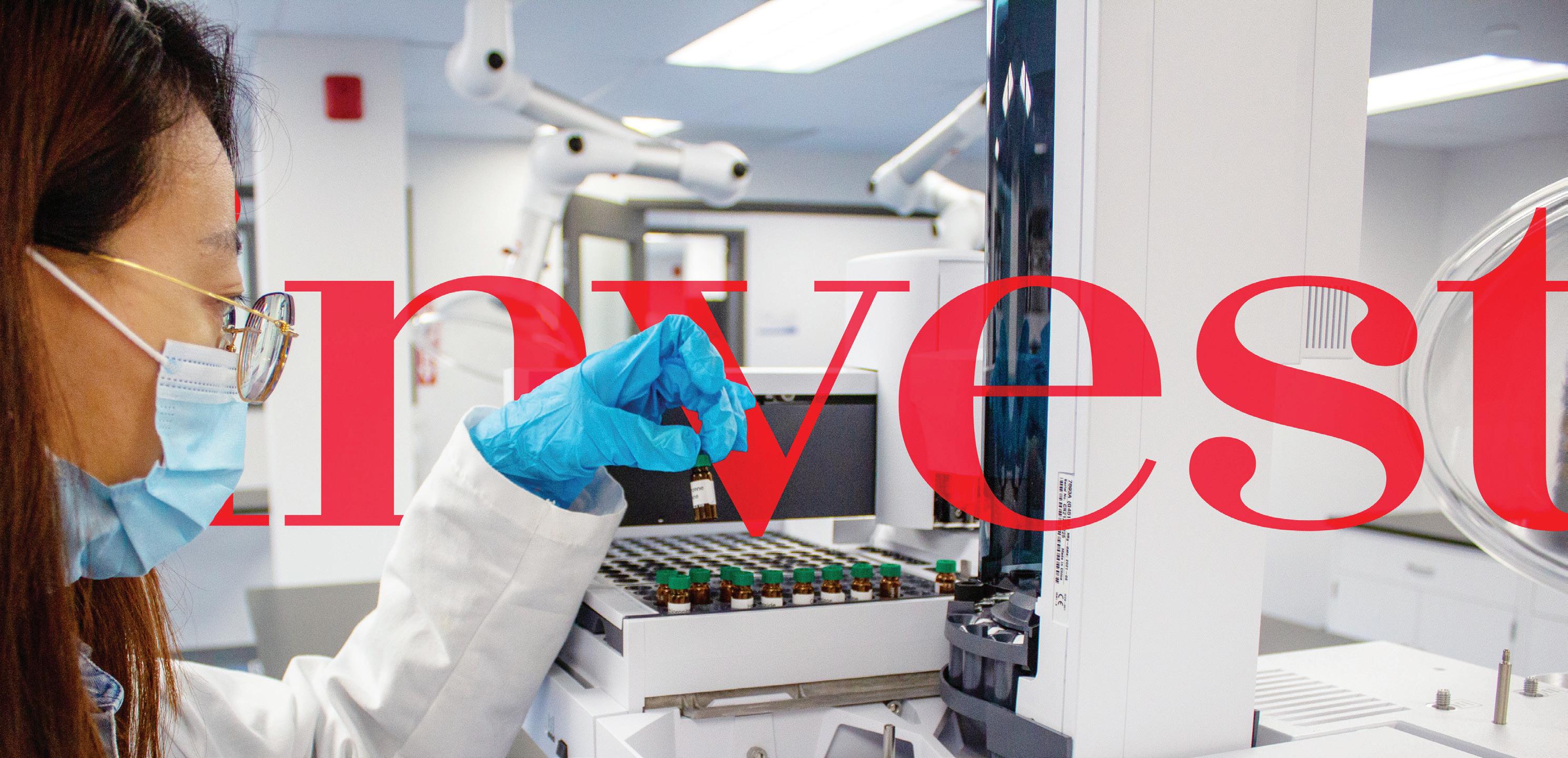


If you wanted to build a revolutionary “Tesla of the water,” where would you set up shop? Montreal? Toronto? Merrickville?
For business partners Cam Heaps and Tim Markou, the sleepy village of Merrickville on the shores of the Rideau River was just the place to put their dream into motion. The duo bought the former Aylings Marina, perfectly located on the river, close to important suppliers and near the U.S. border.
And it’s there that they’re building their new manufacturing operation, Voltari Electric Boats, with the intent of revolutionizing the boating industry.
Using carbon fibre for the body of the boat and an electric motor with seven battery packs, the two men have created a vessel that’s designed to be fast, silent, nonpolluting and nearly maintenance-free.
“Our passion is not just to make an electric boat, it’s to make a better boat and, in doing so, to cleanse the waterways of the world and restore tranquility to our
beautiful waters,” Heaps told EOBJ.
The electric speed boats are equipped with a 160kWh lithium-ion battery pack system capable of speeds of approximately 110 kilometres per hour. Carefully engineered for the marine industry, the high-output system is water-cooled and backed by a 10-year warranty. The price tag of $397,000 is steep, but no expense has been spared on this luxurious water ride.

“Merrickville is our final assembly and testing facility and we put everything together here,” explained Heaps. “We have our upholstery shop downstairs and we add in the (Rockford-Fosgate) stereo system, the wiring and all the 12-volt stuff.”
Not wasting any time, Heaps and Markou have built and tested a prototype. According to the two men, they are ready to take orders and start production of the Voltari Electric Boat.
Not surprisingly, local officials are pretty keen on the venture, too.
“It’s exciting for Merrickville with its historic industrial base and shows that we’re well placed for this type of niche industry to thrive and open other
possibilities for unique environmental industries,” said Merrickville-Wolford Mayor Doug Struthers.
The Voltari prototype had its first launch at Ivy Lea, near the Thousand Islands Bridge. The City of Kingston agreed to install an EV charging station at Confederation Basin in anticipation of the first Voltari boats.
The carbon fibre body of the boats is manufactured at Competition Composites Inc. (CCI), a fibreglass and carbon fibre fabrication service in Arnprior. The hull, the top deck, the consul, the swim platform and the T-top of the boats are all fabricated in Arnprior before being trucked down to Merrickville, where they meet up with the motor and batteries designed and manufactured by LTS Marine in Montreal.
At the Merrickville boat yard, the components are fitted together with the addition of the Garmin-powered “brains” and a touch screen. Finally, the boat is outfitted with a hand-crafted custom interior finish and upholstery.
Right now, Heaps and Markou are building one boat at a time as they clear
and renovate their new boat yard. Then, they’ll ramp up production and expect to hire up to 200 employees locally over the next five years.
The venture began with Heaps, who started Steam Whistle Brewery in Toronto in 1998. By 2008, Heaps, a boating enthusiast, and a friend saw an opportunity to purchase high-end boats in Miami for very little money. At about the same time, they came across carbon fibre.
Meanwhile, Markou, an executive manager in the tech sector, heard about Heaps’ efforts to use carbon fibre and electric motors for marine applications.
“So I thought, wow, look at what Tesla has done on land. If we could do a Tesla of the water, how great would that be? But you can’t just grab those systems and put them in marine, for the same reason I can’t just grab the motor out of my Volkswagen and just drop it into a boat,” said Markou.
The Voltari boats, built entirely out of carbon fibre, are light – a 26-foot boat weighs about 1,100 pounds. That means they can fit seven 440-pound batteries into one boat and get both speed and range.
Besides their profile, speed and absolute silence, the Voltari boats have no fluids in their systems, so there’s nothing to discharge into the water. Plus, they’re virtually maintenance-free.
“If you think of a cordless power drill, people just chuck them in the shed and, whether you use it every day or once a year, you just plug it in and use it. It’s the same with these boats,” said Markou.
The owners of Le Boat didn’t just pivot during COVID-19, they managed a full pirouette.
The luxury canal houseboat purveyor, one of the largest in Europe, responded to the pandemic in a way that not only preserved but also expanded its market while much of the travel and tourism industry floundered.
A global company based in France, Le Boat launched its Canadian operations in 2018 out of Smiths Falls, offering a variety of cruises on the Rideau Canal where travellers rent a houseboat and captain it themselves.

Because its operations in Europe were affected by the global pandemic before COVID reached North American shores, Le Boat had already experienced the disruptions and knew that the product was ideally suited to pandemic restrictions.
“We did a lot to try to drive awareness that Le Boat is in your own backyard and that this is a very safe type of holiday where you could literally explore Ontario’s great outdoors from a luxury perspective,” explains Lisa McLean, marketing manager with Le Boat.
“That was one of the keys for our type of product. We’re not a group tour, we’re not at a campground with other people, you’re floating on your own cottage and in your own social bubble.”
So, just as the pandemic reached Canadian shores, Le Boat was already soliciting coverage from mainstream media outlets that could reach a high-end market of Canadian consumers wishing to explore different aspects of the Rideau Canal.
“Le Boat is a great example of a business that pivoted their marketing efforts to capture a new demographic
of customers during COVID,” says Julia Crowder, manager of economic development in Smiths Falls. “I also believe that by offering shorter vacations — three days instead of their usual seven days — it put the vacation into a price point and timeframe which was more appealing to the domestic market.”
Le Boat targeted its marketing geographically in Canada, McLean explains. “When I plotted where our customers came from, I could see that the clusters were all around (Hwy.) 401, so we really targeted our marketing to people living along the 401 corridor, all the way from Windsor to Quebec and within anywhere from a one- to five-hour drive time.”
Given the turbulence caused by the pandemic, the company doubled-down on efforts to build confidence in the Le Boat brand in both customers and staff, including a full refund policy during the pandemic and now a flight cancellation guarantee.
“So, if your flight is delayed by two days, we’ll hold your boat for you and we’ll only bill you for the days you’re on the boat or give you a refund,” says Mclean. “One of the things I’m proud of is that Le Boat didn’t lay off staff. They did everything possible to make sure all our staff still had jobs. They were even quick to refinance to keep the money flowing through the travel industry. I was probably one of 10 of my friends that still had a job during COVID.”
As a marketing strategy, it was a complete about face for Le Boat, which, when it first set up shop in Smiths Falls in 2018, had focused its marketing almost exclusively on its existing 18,000 customers from Europe, the U.S., Australia and South Africa.
The company, which marked 50 years in business in 2019, can be traced back to English entrepreneur Michael Streat, who in 1969 founded Blue Line with eight boats. Le Boat today is a combination of three companies: Crown Blue Line (originally Blue Line), Connoisseur, and Emerald Star in Ireland.
It offers houseboat rentals that cruise the waterways in France, England, the Netherlands, Belgium, Ireland, Italy, Scotland and Germany, as well as in Canada.
In the company’s first two years of operations pre-COVID in Smiths Falls, 60 per cent of bookings were from Europe, 30 per cent from the U.S., and 10 per cent from Canada, according to McLean. Most were from past Le Boat customers interested in seeing more of Canada by boat, especially since the Rideau Canal is a UNESCO World Heritage site.
The change in tack brought about by the pandemic did not go unnoticed by local municipal officials.
“Their pivot brought new tourists from the region, who discovered not only Smiths Falls, but also all the towns along the Rideau Canal,” comments Crowder. “The town is working with Le Boat to help expand their fleet and provide more opportunities for both domestic and international visitors.”
As a result, Le Boat is expanding not only on the Rideau, but potentially beyond.
“We now have 30 boats and because demand from the domestic market has been so strong, we are getting four additional boats next year, so we’re exceeding our original business plan of only 32 boats on the Rideau,” says McLean. “We’ll have 34 boats on the canal in 2023 and we’re currently looking for a second base somewhere along the canal –hopefully in Ottawa.”
But growth has not been all smooth sailing. “With the demands of COVID, boat sales in Canada are actually up 20 to 25 per cent so it looks like people from Ontario turned to boating during COVID and a lot of people bought their own boats, so dockage space is actually a challenge,” says Mclean.
visit our various attractions, stay for our culture and diversity, work in our bilingual environment, and invest in our growing opportunities.






a


As the Eastern Ontario Regional Network (EORN) continues to build connectivity in the vast region, some municipalities that support EORN are taking their own steps to improve services for their residents.
The townships of Rideau Lakes and Leeds Thousand Islands both went out on a limb to explore solutions to help overcome their specific challenges.
“We decided to go our own route because we didn’t see progress moving fast enough,” Rideau Lakes Mayor Arie Hoogenboom told EOBJ, adding, “We are supporters of EORN and the work they’re doing — it’s great work, but it was going to take years.”
“Although the township supports EORN, it recognizes that the EORN model is not ideal for the township’s particular challenges,” said Stephen Donachey, chief administrative officer with Leeds Thousand Islands.
“We support whatever municipalities are doing to improve connectivity for their residents,” said Jim Pine from EORN, adding that EORN recognizes that it can’t provide services quickly enough or in the format that some areas need.
EORN is currently working in partnership with Rogers Communications to close gaps in cell coverage in the region. According to Pine, Rogers will be building an additional 256 towers and upgrading existing towers to improve cellular service.
“As we build new towers, Rogers is able to come along and add fixed wireless, but they’re paying for it, we’re not,” said Pine.
Both Rideau Lakes and Leeds Thousand Islands are rich in lakes, Canadian Shield rock and old-growth trees. In Leeds Thousand Islands, there’s the additional challenge of rolling hills and a sparse population spread over a large area with few urban centres. The terrain means that fixed tower connectivity leaves too many residents with poor to non-existent service.
Each of the townships took a different approach to the challenge. Rideau Lakes chose a public/private partnership, while Leeds Thousand Islands decided on a publicly funded model supported by government grants.
By the end of this year, 1,400 homes in Rideau Lakes will have gained fibre-to-the-home (FTTH) and 1,200 homes will get 50/10mbs fixed wireless via broadband tower upgrades, while many more are getting improved fixed wireless reliability and capacity through fibre backhaul. All homes and businesses in the township’s villages — Portland, Elgin, Delta, Lombardy, Newboro and Chaffey’s Lock — will have access to FTTH. That represents more than 40 per cent of the township’s properties.
“I think we got it right, I know other municipalities have tried to do too much too quickly, but we also had some opposition initially from our own council in terms of getting into the partnership,” said Mayor Hoogenboom.
On the other hand, the Leeds Thousand Islands project stalled when the federal government rolled the Universal Broadband Fund program over to the province, which, in turn, changed the criteria for funding under what it called the Improving Connectivity for Ontario program.
“Essentially, the province decided to run an RFP process where only established internet service providers (ISPs) can bid to receive territories to provide internet services and receive funding assistance from the province,” explained Donachey. “I suspect that, if an ISP bid the territory in which Leeds Thousand Islands falls, it will likely provide fixed wireless internet services (such as towers), as it is the most cost-
effective, rather than running fibre optic cables to each home, which was the approach to be taken in our network design.”
While Leeds Thousand Islands is disappointed with the change in funding formula, officials are not giving up entirely.
“I have reached out directly to the provincial government to seek answers on how it will ensure high-speed internet access for the township,” said Mayor Corinna Smith-Gatcke.
Meanwhile, by the end of this year, Rideau Lakes will have a $5.2-million system that cost the township $880,000.
“My understanding is that this contribution rate (16 per cent) is considered exceptional value on the dollar in the industry in terms of rolling out fibre via a partnership like this, especially in a rural setting,” said Mike Dwyer, chief administrative officer with Rideau Lakes.
Certainly, it seems the investment is paying off, because in just the last year the township saw record growth, with 80 new homes being built when the norm is closer to 25. That means new tax revenue to the township will help offset the investment quickly.
“Likely not in a single year, but definitely over a short period of time, as this is all new development that will be taxed at market value; so good for the township, county and school board,” said Mayor Hoogenboom. “In addition, properties with better connectivity increase in value. So, I believe taxpayers will see a significant short-term return on this investment.”
From a business perspective, it seems likely that installing fibre optic lines in Delta weighed positively on the decision by Willows Agriservice to not only stay in Delta,
but to invest in a $10-million expansion.
In 2019, when Rideau Lakes issued an RFP, officials were gratified to receive five separate submissions.
“Unique to our process was keeping it simple and also engaging two independent industry experts to assist with the technical language in the RFP as well as scoring the resulting submissions,” explained Dwyer.
As a result of the competitive process, the township entered into a three-year build-out agreement with WTC Communications. WTC chose to go with a mix of fibre and fixed tower services.
“We try to go with FTTH wherever we can because we see that as where the technology is going,” said Mike Lynn, CEO of WTC.
“Fixed wireless is great and it makes sense in places where fibre is difficult to install. Right now, FTTH exceeds the need but it’s futureproof.”

“We have been able to build a great working relationship with WTC,” said Dwyer. “This has been both at the operational level — such as coordinating roadwork to allow conduit to be laid before the new road surface is applied — and the administration level, which resulted in two grants … being gained to expand the project.”
With the project already rolling, WTC was able to secure an additional $1.2 million from the two government grants, one provincial and one federal, to expand the project to reach more homes and businesses.
“So, it made the project quite a bit bigger. It’s been a successful partnership and we’re happy with the rate of return and compare it to places that have more dense populations,” said Lynn.
While not all the councillors in Rideau Lakes were on board with spending public money on the project, Mayor Hoogenboom’s argument was that it’s an essential service.
“I treated it as the infrastructure of this century. We’ve always been involved in building roads and bridges and picking up garbage. Internet and cell connectivity is the infrastructure of today.”
Latham Group Inc., one of the world’s largest manufacturers of fibreglass pools, is expanding its Canadian operations by building a state-of-the-art pool manufacturing plant in Loyalist Township just outside of Kingston and will be hiring up to 200 people over the next several months.
“This will be the largest fibreglass manufacturing facility for Latham and largest ever investment made by Latham in its 66-year history,” said Sanjay Jain, Latham’s fibreglass operations director in Canada. The company is based in Latham, N.Y.

According to Jain, the inground pool market is undergoing a “material conversion”



as consumers learn that fibreglass pools are better made, cheaper in the long run, easier to maintain and more environmentally friendly.
“Fibreglass pools need less chemicals to maintain the quality of water in the pool on an ongoing basis. Because of the smooth, non-porous finish of fibreglass construction, you don’t need as much chlorine,” said Jain.
Latham has more than 30 manufacturing plants around the world making fibreglass and in-ground vinyl liner residential pools and components, including automatic pool covers and solid and mesh safety covers. The company already has two plants in Canada outside Toronto that manufacture packaged pools, vinyl pool liners and pool covers.
The publicly traded company, worth US$668 million as of September 2022, has been looking to improve its capacity to serve the Canadian and northeastern U.S. markets for some time. In 2021, the company chose Loyalist Township because of its location between Toronto, Montreal and Ottawa and its easy access to markets in eastern Canada as well as the northeast and upper-midwest of the U.S.

“We welcome Latham, it’s a major
employer for us, we hadn’t welcomed an employer of that size in years and since then we’ve used what we learned from our experience with Latham to sell the township to other interested investors,” said Steven Silver, chief administrative officer with the township.
Situated on 148 acres of industrial land off Taylor Kidd Boulevard, the 160,000-squarefoot facility will be fully automated with a program logic controller (PLC) system to improve material handling and safety.
“PLCs are very common in a petrochemical industry, not as common in the fibreglass manufacturing industry. We’re bringing some really new concepts of material handling and material delivery to the user,” said Jain.
Shovels went into the ground earlier this year and the plant is well on its way to completion, with plans to start production at the new facility in the spring of 2023.
Most of the new hires will come from within a 30- to 40-km radius of Kingston.
Embrun, Russell, Limoges and Marionville are attractive communities to live, work and operate a business. Lead the region with a 18.6% population growth rate (Census 2016 2021)

Ready for investment sites Terrains prêts à l’investissement www.russell.ca/availableproperties
There was a dignified excitement in the air as elected officials, municipal employees and business representatives gathered to network, showcase and learn from one another at the Ontario East Municipal Conference last month in Cornwall.
One issue that was top of mind for most
delegates was the electric vehicle supply chain industry. More than $6 billion in EVrelated investments has been announced for the region in the past few years.
“I think that’s the exciting thing about the EV sector; I think it’s going to continue to roll at a really aggressive level,” said Stephen Paul, director of community and development services for the county of
Lennox and Addington.
With Kingston’s Li-Cycle, an EV battery recycling company, and global giant Umicore’s recent announcement of a first-ofits-kind battery materials production plant being built in Eastern Ontario, there’s a lot of opportunity in the EV landscape.
“So, with Umicore on the upstream and Li-Cycle at the end of life or new life, it gives
SPONSORED CONTENTIt’s little wonder the municipality of Casselman is poised to enjoy significant growth over the next few years. Already home to many robust businesses, new arrivals are injecting fresh energy and employment opportunities into the local economy. Add in an abundance of outdoor recreation and easy access to Ottawa, Montreal and the United States and the formula for an ideal place to work and live is complete.
“It’s an exciting time for Casselman,” says Mireille Groleau, the municipality’s communications and economic development officer. “We are seeing so much interest among businesses ranging from small start-ups to large companies. We are able to show them that everything is in place to welcome them and support their success.”
Casselman’s strategic location is key. The scenic South Nation River, offering abundant recreational possibilities, creates an appealing, tranquil vibe that easily lures people away from larger centres. Highway 417 makes road travel in and out of the community a breeze,
and with regular Via Rail service and easy access to airports in Ottawa and Dorval, Casselman is proud to be the place where so many good things are happening.
Casselman’s appeal also stems from a concerted effort by the municipality to make room for additional commercial and industrial operations which will yield even more employment opportunities.

“We have a young, bilingual, educated and dynamic workforce who appreciates the ability to live in such a friendly and welcoming community.
All the advantages of the big city are close at hand plus there is an incredible quality of life,” says Groleau. “We also have available land zoned for industrial and commercial plus some vacancies in the existing built space and all the secondary industries including skilled trades are here. As well, there is land already zoned to support our anticipated housing boom, with 1300 new units to be built in the next 3-5 years.”
Known for its innovative approach to economic development, Casselman proved a welcoming location for Ford Canada which is opening a 500,000 square foot distribution centre in early 2023, creating 150 new jobs as well as opportunities for other businesses. Ford was impressed by the fact that Casselman was not afraid of adapting to a company’s needs for municipal services, notes Groleau.
Casselman’s reputation as a ‘green community’ is unparalleled. From canoe, kayak and stand-up paddleboard access to the South Nation River at High Falls Park to the planned million-dollar bird sanctuary, featuring walking trails, art installations and an observation centre, the tourism and recreation markets are

us an opportunity with companies within the sphere, whether its sub-manufacturers, assembly or any company looking into innovation to fill the gaps,” said Abdul Razak Jendi, investment manager with Kingston economic development.
More than 300 delegates gathered at Dev Hotel and Conference Centre in Cornwall, formerly the Nav Centre, for the conference to share ideas and new initiatives.
“We’re very pleased with the turnout after two years of virtual conferences,” said Jay Amer, executive director of the Ontario East Economic Development Commission, the non-profit organization that organizes the event.
thriving in tandem with the industrial, construction and business sectors.
Now that the pandemic is under control, the very popular Christmas Light Festival is making a coming back on December 1st -4th. With its artisans’ boutiques, a Habs Alumni game, a street hockey tournament and a special show featuring Roch Voisine, it is sure to bring participation back to its pre-2019 levels.
The municipality’s proactive approach to encouraging and sustaining growth means it is constantly looking for inventive ways to meet the current and upcoming needs of residents and businesses.“To say our future is bright is a genuine understatement. Come for a visit and see for yourself, or contact me (mgroleau@casselman.ca) to find out more.”
There isn’t much left to identify the Northcote area of Renfrew County, originally made famous by author, broadcaster and storyteller Mary Cook. Cook grew up there in the 1930s and built a massive audience with her cheery reminiscences and down-home tales of adventure on the farm.
By all accounts, Northcote, just outside of Renfrew, was once a vibrant farming community with all the basic services and home to several tight-knit families. Cook even guided crowded bus tours to Northcote to see first-hand some of the locations described in her books.
Today, though, there is little that remains of the community. “We haven’t been able to find any evidence that it still exists,” says the Roadside Thoughts Gazetteer, an online encyclopedia of communities and places.
Fortunately, another entrepreneur is now trying to put Northcote back on the
map. Andi Marcus, who identifies as a “gourmetologist,” certainly doesn’t come from a farm, but instead is a true city girl and former cosmetics exec who grew up in Europe. Marcus once pitched her company, Mistura Beauty Solutions, to CBC’s Dragon’s Den and is a former OBJ Forty Under 40 recipient.
Her current venture is trying to make an impact as sizable as Mary Cook’s from what was once a battered stone farmhouse on Northcote Rink Road. Marcus has already made her getaway a destination for many people and wants to increase the draw.
And Marcus isn’t just telling tales. She’s offering “farm, fresh and fancy” dining and overnight stay experiences under the banner The Babbling Gourmet.



Why babbling, she’s asked? Pretty simple, she says: “I tend to talk a lot.”
She then launches into a long description of her dinner parties, sleepovers and private chef services.
In fact, Marcus has trademarked a new concept she calls DineOver, which takes the
bed and breakfast concept and reverses it. Under the concept, overnight stays are an extension of lavish dinners that bring in food lovers and oenophiles (wine connoisseurs, for the rest of us) from far and wide for all-inclusive stays. Marcus says her food selections take “farm-to-table gastronomy to the next level.”
She feels the concept will soon become a growing trend. “I see the overnight stay, or DineOver as I have affectionately named it, as an extension of the dinner parties we host here … not the main objective,” she says.
The move six years ago from Ottawa’s posh Rockcliffe neighbourhood to the Briscoe farm in Northcote was predominantly for financial reasons, Marcus explains. After experiencing the ups and downs of running Mistura, she sold the business to a Kingston-based company. It became the catalyst for a “lifelong dream come true.” Prior to the move, rampant big business stress had begun to take a toll on her mental and physical health.
She heard through contacts that Bob Briscoe planned to demolish a 3,000-square-foot house he no longer had use for that sat on 350 acres of cropland he had plenty of use for. It’s not uncommon for farmers to remove empty homes when they expand their land holdings.
‘RUSTICALLY ELEGANT VIBE’ Marcus went to see the heritage stone gem and cut a handshake deal to transform the house for guests in return for paying the hydro, renovations and upkeep. Briscoe installed a new furnace and Marcus estimates she invested $100,000 to inject a “rustically elegant vibe.”
Meal ingredients are sourced locally with the establishment’s kitchen garden providing organic vegetables throughout the summer.


Cost of an overnighter in one of three guest suites, including multi-course dinner and breakfast, is $150 per person. Weekly rates can be arranged.
Now comfortably ensconced in their new gig, Marcus and husband Hayden have become active locally, sitting on the board of the community centre and participating in the Renfrew Victoria Hospital fundraising drive.
To accommodate more diners, they are renovating to create a 12- to 16-seat bistro and commercial kitchen at the farm. The Babbling Gourmet also offers food stations, buffets and cocktail party catering for up to 100 guests, both on- and off-site.
Over the last year, we’ve been using this column to have a conversation about the positive opportunities that exist in Ottawa and Eastern Ontario to change and grow our organizations as we emerge from the pandemic.
Still, while we’re learning to live with the health-related risks of COVID, the economic hangover of the past few years – from supply chain disruptions, to labour shortages, to pressures caused by inflation – continues to fuel a sense of disruption.
Perhaps I’m an optimist, but I’d like to make the case that we’re prepared to handle these storm clouds in Canada, and even better positioned here in Ottawa.
There are three areas where I believe Ottawa and the National Capital Region have an opportunity to lead in ways that will drive longterm growth for our community.
It is impossible to overlook the impactful and stabilizing force government has on our local economy. It is also reasonable to recognize federal spending and hiring in the decade ahead will not match what we’ve seen over the past 10 years, and through the pandemic.
What is encouraging however, is the leadership and focus we are seeing in shifting the way government works, and how it delivers services by harnessing technology.
It’s a shift that aligns nicely with where Ottawa leads outside of government, in our technology sector.
Last month, Treasury Board president Mona Fortier, and chief
information officer Catherine Luelo released a forward-looking document called “Canada’s Digital Ambition 2022”.
It’s a visionary re-think of government service delivery and operations with digital transformation and adoption placed squarely in front.
I’m keen on the contents of this plan as it seeks to address some of the “red-tape” roadblocks that have long been identified as holding back private sector growth and innovation.
As our BDO team advises our clients on everything from taxes to technology transformation, this “digital-first” vision for government reflects what Canadian businesses need to be both efficient and competitive.
It’s a bold vision and welcome undertaking that stands to help make both government, and Canadian enterprise, more efficient, agile and innovative.
2. Leadership in data, analytics and business optimization
We’re also encouraged that the downstream impact of this digital ambition plan will dovetail with leadership we’re already seeing from Ottawa-based technology organizations in areas as diverse as supply chain management and clean energy technology.
This practical know-how and capacity will help serve as a foundation for government and industry to align on common economic objectives where technology and innovation are key drivers.
Climate change and clean energy are great examples where government priorities – including
the need to measure, report and regulate outputs and outcomes –will rely on technology solutions to achieve business goals. Concurrently, large enterprise, including natural resources and energy firms, are focused on practices that optimize operations to reduce environmental impacts.
It’s a win for government and industry when innovative solutions can be applied that meet mutual objectives, while serving as critical tools for the government as they seek to achieve ambitious and complex industrial policy objectives in areas such as battery construction for electric vehicles.

Kanata-based Kinaxis is a fantastic example of a firm harnessing data to manage complex organizational supply chain challenges. By extension, this local leadership is helping to incubate knowledge around data, analytics and business optimization.
We’re also proud of the work our BDO Lixar team has been doing with clients in the renewable energy sector to optimize operations, including the use of weather and climate data, to support planning and investment decision-making.
Where we saw government play a formative role in Ottawa’s telecommunications industry 65 years ago, an ambitious digital agenda has the potential to stimulate our regional technology sector in the same way.
There’s one other trend we’re seeing that will help to benefit our local technology sector. It’s the resurgence and growth of Private Equity (PE) and Venture Capital (VC) investment.
The trendlines are encouraging. In 2021, there were 771 private equity deals worth $18B completed in Canada in 2021 (Source: CVCA). Every indication suggests we’re on track to surpass this number in 2022.
Despite inflationary challenges, we continue to see investment in Canada from PE sources domestically as well as from the United States and overseas. It’s a vote of confidence in the direction Canada is headed.
More importantly, with many of these investments aimed at technology firms, it’s recognition of the capability and expertise of what we have to offer in Ottawa’s technology sector.
This access to PE and VC funding is further helping to drive and commercialize innovation. Combined with accumulated knowledge locally, this capital is supporting a platform from which local technology leaders can pursue an idea or vision.
As I started off the column, we’re hardly at ease.
But (and perhaps it’s the resurgence of our Ottawa Senators that has me feeling upbeat) I’m encouraged by the direction we’re headed in the city.
We’re seeing positive signs of alignment with government and our technology sector. At the same time, local technology enterprises and entrepreneurs have the ability to access capital to pursue new ideas that can feed into this collective digital transformation.
It’s this converging path that will help us through the bumps in the road we may encounter in the days ahead.

They opened Bubba & Bugs Coffee Bar in Kemptville on March 27, 2020, right at the start of the pandemic, and somewhere along the way got designated a “queer safe place.”

“It never occurred to us to close; we were committed – it had to work,” says Scott Godwin, otherwise known as Bugs. “We didn’t have a plan B and there was no turning back.”
“We were not going to be victims, we decided to forge on and be positive and appreciative,” adds Luc Vincent, or Bubba. “I think we made a conscious decision to be creative, have fun regardless of what was going on.”
Their strategy was simple. They took to social media. They started organizing events like virtual drag queen bingos, creating fun videos and celebrating every annual event with something special like a red-and-white smoothie for Canada Day or adding fun Halloween decorations and treats, always with a touch of mischief and humour.
They took the time on social media to engage with their customers and, to a large extent, credit that engagement with their success.
“A lot of people come for the engagement, they don’t mind waiting 20 minutes because they know they’ll get their 15 minutes with us at the counter,” says Vincent. The cafe serves hot and cold beverages, as well as lunch and brunch items and a tempting variety of sweet treats.
They both agree that it seems a little surreal to look back at the months of the pandemic and realize they’re still in business.
“The one thing we learned from the pandemic was that, you can plan as much as you want, but life will dictate what happens. It’s your ability to adapt, to show up, stay strong and stay true to yourself that will carry you through,” says Godwin.
As far as designating their café as a queer safe place, it happened organically.
“We didn’t really do anything official; it was the youth that came in here that designated it that way,” says Godwin.
Originally from Kemptville, Godwin says growing up in the community wasn’t a great experience; at the time, it wasn’t a safe place to be openly gay.
“There has been remarkable progress since then,” he says.
He left in 1997 and headed to Toronto, where he met Vincent, also from rural Ontario. When the couple decided to give up their day jobs and open a café together, they knew they wanted to be somewhere in Eastern Ontario. Godwin’s mother still lived in Kemptville and when she found out that one of the local cafés was closing and coming up for sale, she let them know.
As it states on their website, “Do they know all there is to know about coffee? Nope. However they do know love, they know friendship, they know family, they know dreams and that is exactly what you will taste in every cup, every plate and what you will (they hope) feel every time you step through the big pink door.”


What started out as a sideline in response to a client’s query is now big business for GanReel, a company that had its genesis in the business of building wooden boats. When a gentleman approached owner Tom Conner in 1996 to ask if he thought he could produce wooden reels for the commercial cable industry, Conner replied, “Sure, why not?”
Today, the company now known as GanReel Manufacturing Inc. is part of a significant cable and reel ecosystem in Eastern Ontario. Now run by the late Tom Conner’s son, Jeff, the company operates in a 40,000-square-foot building in Gananoque and it’s adding another 5,000 square feet as part of a recent expansion project. Sales have more than doubled in the last year alone, and Conner is always looking for more employees to add to his roster of 30.

“It’s a huge challenge maintaining staff,” Conner says. “There’s no doubt about that. I mean, you see it all over.”
GanReel calls itself the “premier Canadian manufacturer of wooden reels.” It specializes in wooden and plywood reels as well as custom crating, boxes and skids. It currently supplies all the major customers in Eastern Ontario and beyond.
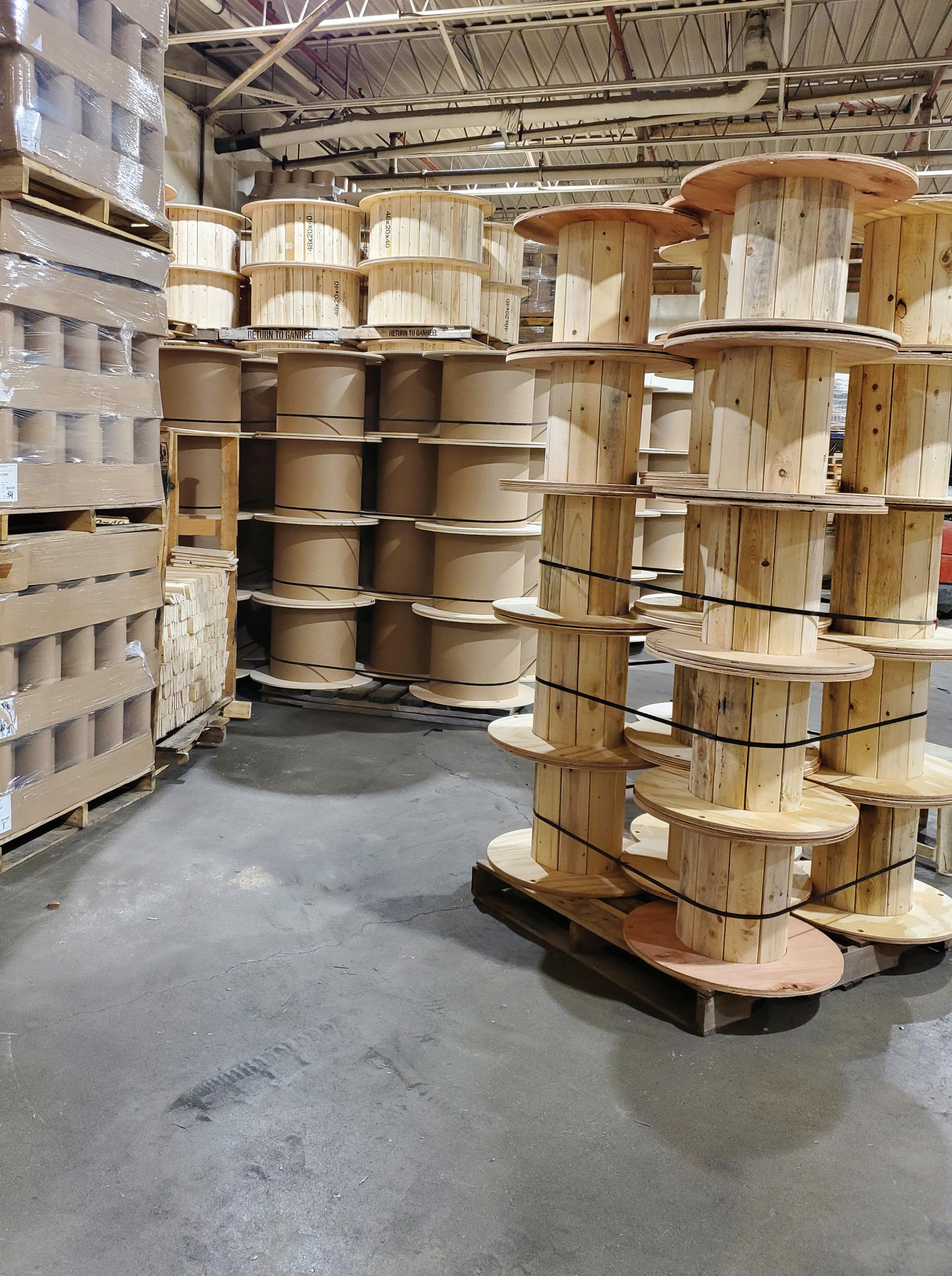
A wooden reel manufacturer GanReel Manufacturing Inc. that serves the strong commercial cable ecosystem in Eastern Ontario and has clients across Canada signed on to Launch Lab’s Amplify program to help it scale its business.
T H E I NN OVATI O N C E NT R E LE CE NT RE D’INNOVATIONJeff Conner
Conner isn’t sure why, but, in the past three years, GanReel’s customers’ businesses have grown significantly, but he’s pleased that his has alongside them. To manage the growth effectively, he approached the business experts at Launch Lab and joined the Amplify program, one that helps Eastern Ontario companies accelerate their growth and scale.
“When we approached Launch Lab, we were looking for funding to support our new expansion,” Conner says. “We had never been through an expansion of this size or magnitude, so we were looking for significant capital.”
Conner’s bank manager at RBC suggested he reach out to Launch Lab for help in making a convincing plan that would give the bank confidence in lending him the capital he needed.
Conner describes that outreach as “the best move we ever made,” and says he doesn’t think GanReel could have pulled off the expansion without the advice of Launch Lab’s entrepreneurs in residence guiding them through the process. RBC agreed to the business plan the team proposed and the expansion is now under way.
As a result, GanReel now has more space in its existing building and has undergone some renovations as it awaits the key part of the expansion — a newly automated equipment line.

“If all goes according to plan, it should arrive here early next summer,” he says.
Conner’s experience with Launch Lab was so positive, he decided to stay in the program, which means he meets regularly with his Launch Lab advisers.
“We meet with Launch Lab on a quarterly basis to conduct a quarterly business review, just to make sure we’re heading on the right track,” Conner says. “They always have some ideas that might help us move things along. We would have never been able to get to where we are without their knowledge and experience.”
Scott Runte, CEO of Launch Lab, says the company needed help understanding how to finance the purchase of the equipment that will drive automation and allow it to meet the demand it’s been seeing in the past few years.
“It’s a really great company and a great story,” Runte says.
Conner says his father, who retired in 2005 and just passed away in June, was thrilled by the growth in the business.
“He thought what we’re doing out here is just fantastic,” Conner says. “He was really excited about the expansion.”
They (Launch Lab) always have some ideas that might help us move things along. We would have never been able to get to where we are without their knowledge and experience.
–Jeff Conner
Launch Lab partners with several like-minded organizations and the St. Lawrence Corridor Economic Development Commission is a frequent collaborator.
We don’t do what we do without partnerships.”
It’s a familiar refrain of Scott Runte, president and CEO of Launch Lab, a regional innovation centre that pairs entrepreneurs with its team of experienced business owners in Eastern Ontario to help them grow and scale.


“Across our region, economic development partners have always been valuable partners for us because they are well connected in the regions they serve,” Runte says. “Right across Eastern Ontario, they have their finger on the pulse of companies and industries that are important in their region, companies that are growing and companies that are facing challenges.
One such fruitful partnership is with the St. Lawrence Corridor Economic Development Commission, an organization that was launched five years ago by a group of municipalities between Kingston and Cornwall. Its goal is to promote economic growth by attracting investment in the industrial and commercial sectors in this region.
“And through that attraction, we want to create quality jobs for Eastern
Ontario,” says Charlie Mignault, who heads up the commission and who also serves as a member of the board of Launch Lab.
The Commission focuses first on attracting mature companies, often global ones, to Eastern Ontario. Its secondary focus is to help support highgrowth firms that have scaleup potential. Mignault’s job includes helping scaleup firms identify possible capital, whether through angel investors, traditional banks or venture capitalists.
“I’m meeting with businesses to better understand their challenges and opportunities,” explains Runte regarding the complementarity of the two organizations. “When we meet with clients, we want to connect to partners such as the commission, because it has a mandate to identify programs and provide support to help clients grow and scale. The St. Lawrence Corridor Economic Development Commission is a valuable partner for us in understanding the industries and companies that are growing along the St. Lawrence River.”
Mignault says he’ll often refer businesses to Launch Lab’s services.
“Both the Corridor and Launch Lab are actively supporting firms across the region; meeting with businesses, entrepreneurs and investors. The services we provide to clients is symbiotic; ultimately we are providing advisement and resources to enhance productivity and business growth.” Mignault says. “It’s very complementary. This week, I met an entrepreneur who needs to invest in some machinery and equipment to take that next growth step for his business so I’ve recommended some of Launch Lab’s advisory services.”
The commercial cable ecosystem in the area is one that has benefited from the services of both organizations and both appreciate the supply-chain integration that is part of that ecosystem, with cable producers such as Northern Cables and
Prysmian as well as cable reel builders such as GanReel Manufacturing Inc. Mignault says the GanReel story is a great one.
“There’s been so much disruption in the global supply chain since COVID that many of these manufacturers have reformed their supply chain from global to regional or local,” he says.
“One of the things we’ve focused on at the commission since COVID is identifying suppliers in the regional ecosystem so when variability or challenges occur, manufacturers have a local supply chain with local service providers to ensure their operations proceed without disruption. So it’s great to have companies growing such as GanReel in the area to support this cluster of wire and cable manufacturers.”
No. of jobs: 688
Five-year growth rate: 290 per cent Sector revenues: $620 million
the team started turning a profit and the company has been growing ever since.
Bacon says the gentlemen who allowed his team to work rent-free in their building also brought some business sense to the operation and gave them advice on how to conduct themselves in this new world.
“They surrounded us and protected us from the bulls,” Bacon says. “It was an excellent relationship.”
These days, the latest project at Northern Cables is building a standalone medium-voltage plant to manufacture the kind of cables used to feed power into mines and feed power in remote areas.
When Phillips Cables decided to leave Brockville in the 1990s, Shelley Bacon and six colleagues found themselves out of jobs, so they regrouped and five of them eventually started their own cable company in Brockville. Fast forward to 2021 and Northern Cables is celebrating its 25th anniversary.
Given that the group started the company with “no product, no facility, no machinery and no market,” it’s been a good run. Today it has 275 employees at three different manufacturing plants — one in Prescott and two in Brockville — that run 24 hours a day, seven days a week and produce 70 million metres of cable annually for the industrial and commercial markets in Canada and the United States.


Starting out, Northern Cables accessed services similar to the ones that today Launch Lab could have helped facilitate and further down the road, the company did indeed consult Launch Lab. But back in the 1990s, it found some local angel investors who were willing to take a chance on the engineers who were starting anew and who were willing to trade rent for some equity. After about three years of trial and error in running a business, and, later, an injection of capital,
Northern Cables’ principals have consulted with Launch Lab’s president and CEO, Scott Runté, as well as Charlie Mignault, commissioner of the St. Lawrence Corridor Economic Development Commission.
Runté commends Bacon and his team for recognizing 25 years ago that the cable industry wasn’t dead in Eastern Ontario and that Phillips’ decision to pull out was that of a multinational corporation, rather than an indictment of the prospects in this part of Ontario.
“This is an example of a company that has grown, expanded and invested in Eastern Ontario,” Runté says. “And they got started because angel investors supported them from the beginning.”
Runté also points to the fact that Northern Cables wants to grow its business in Canada and in Eastern Ontario to be specific.
For his part, Mignault sees Northern Cables in a “high growth – scale of phase of their evolution that’s investing in research and development and hiring people as fast as they can.
“I knew they were true entrepreneurs when they said, ‘Hey, this is still a great product. We know how to make it. We have the workforce and the training,” Mignault says. “And so they found some investors to come on board and support them. And it’s been an incredible success story for Eastern Ontario.”
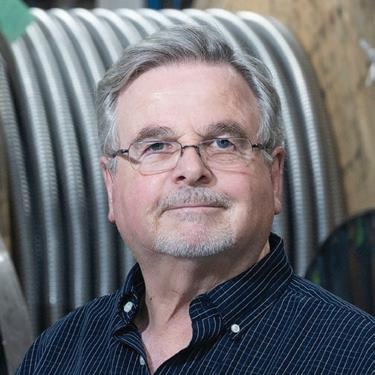
Northern Cables was started by five engineers who lost their jobs when Phillips Cables pulled out of the region. Today, the company employs 275 people in Brockville and serves customers across Canada and in the U.S.Shelley Bacon CEO Todd Stafford President
This is an example of a company that has grown, expanded and invested in Eastern Ontario.–Scott Runte
T H E I NN OVATI O N C E NT R E LE CE NT RE D’INNOVATIONSPONSORED CONTENT
For generations, the Carp area was known as a tranquil village, surrounded by farmland. The landscape has been changing, however, and today the Carp Road Corridor (CRC) has the distinction of being Ottawa’s largest light industry business park.

Supporting the area’s transformation is the Carp Road Corridor Business Improvement Area (CRCBIA), whose executive director, Roddy Bolivar, has led the organization since its inception in 2011. He is uniquely poised to reflect on the CRC’s evolution, given that many years ago his father worked at the Carp Municipal Airport – which continues to service the area today – and there are photos of a three year old Bolivar onsite.
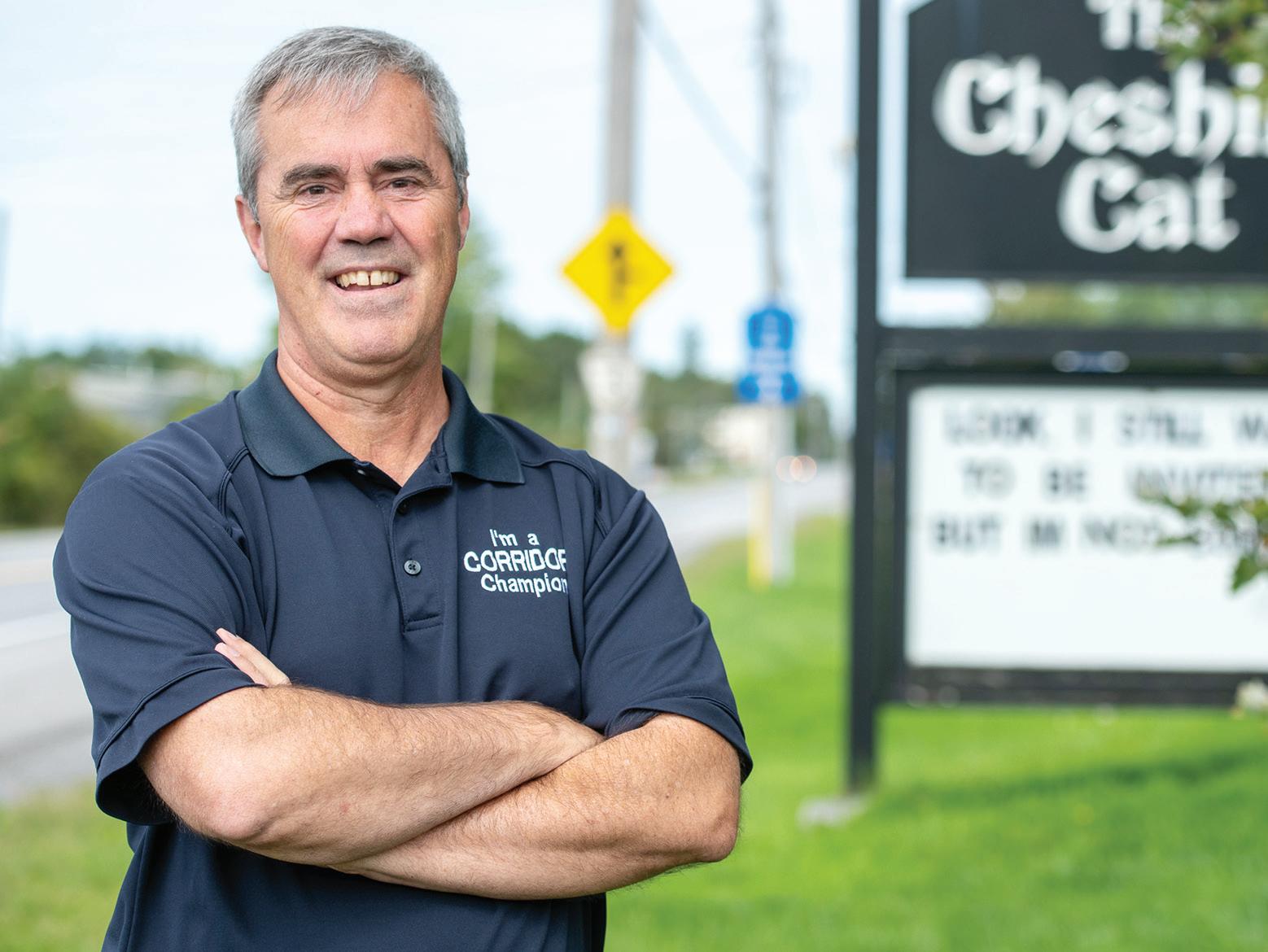
The BIA’s priority to date has been to obtain approval to extend municipal services into the business area. Other key issues include seeing public transit in the area and road improvements to maintain efficiency for business activity.
Bolivar liaises regularly with over 250 business and property owner members and works to attract new businesses. He estimates there are double the number of businesses today – employing over 3500 – as there were a decade ago. One example
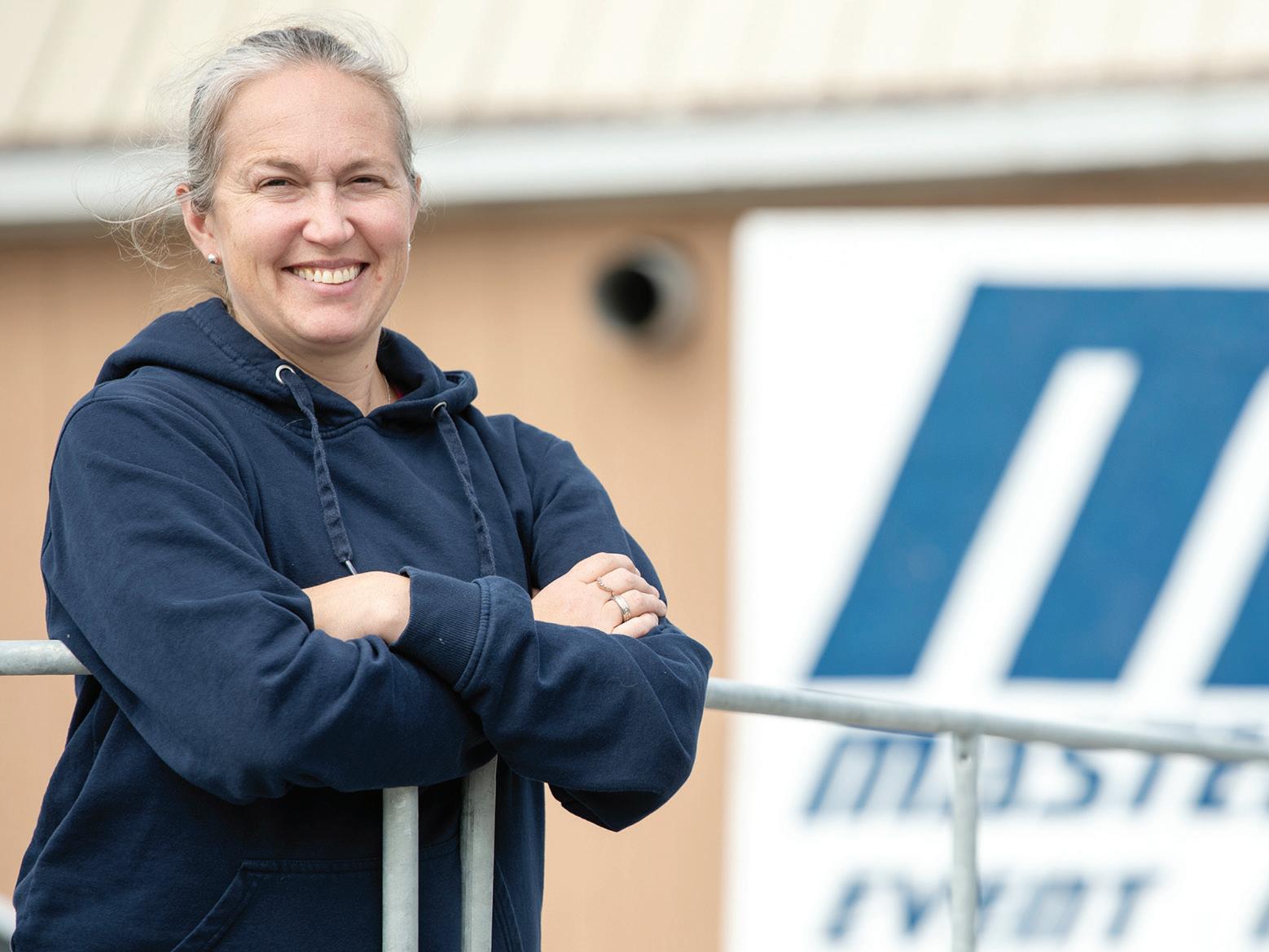
is Mastermind Event Rentals, which relocated in 2020 to the CRC from the Kanata North Business Park. The company provides rental solutions for events of all shapes and sizes, making the process easier and more cost-effective for clients.
Mastermind co-owner Jennifer McAndrew explains that the move was driven by a need for more space and a longstanding desire to own the building the business occupies, to better control expenses and pricing. They were drawn to the CRC because of its accessibility and proximity to Highways 417, 416 and 7. She says both clients and suppliers are finding the location – just three minutes west of the Canadian Tire Centre – very convenient.
“The property we purchased included a home for our family as well as an historic agricultural building, which we modernized while still keeping some of its original character,” she notes.
McAndrew feels fortunate that Mastermind was able to ride through the pandemic while establishing themselves in their new location and
says they are very optimistic about continued forward momentum.
“We’ve really felt embraced by the CRC business community,” adds McAndrew. “We’ve met so many other small business owners through the BIA. It seems we all share similar values as well as a sense of excitement about the area’s continued potential for growth.”
And what would she say to someone contemplating making a similar move to the CRC? “Just do it. For us it was a good family decision as well as an excellent business decision.”
Bolivar echoes that sentiment, noting that new businesses are always welcome to participate in the BIA.
“The more voices the better and we can also introduce you to other businesses with whom you may have a synergy. Just know that in the past few years there has been lots of interest in the area’s vacant property which we expect will turn into new businesses soon, so don’t wait too long to come visit,” he adds with a smile.
We’ve met so many other small business owners through the BIA. It seems we all share similar values as well as a sense of excitement about the area’s continued potential for growth.
For nearly 20 years, Competition Composites (CCI) has manufactured composite products for, as its website promises, “pretty much anything you can imagine” for clients all over the world. The list includes panels for bus shelters, emergency shelters and utility structures, tanks of all shapes and sizes for aquaculture and hydroponics and radomes for use high in the sky or even under water. Inside its 18,000-square-foot Arnprior facility, CCI’s big push these days is narrower and decidedly regional in scope. It is building components — the hulls, decks, consoles and bimini struts — for an innovative line of carbon fibre electric boats being produced by Merrickville’s Voltari Electric.
Northern Cables Inc. is a Canadian-owned and -operated wire and cable manufacturer specializing in armoured cables, in copper and aluminum conductors. These power cables are manufactured across three Eastern Ontario factories — one in Prescott and two in Brockville, employing more than 270 people — and used in a multitude of commercial and industrial applications across Canada and the United States. What’s more, Northern Cables is deeply committed to supporting its domestic supply chain. It sources all of its base materials — aluminum, copper and plastics — from North America.
Hawkesbury’s Tulmar Safety Systems designs, manufactures and distributes engineered protective textiles, survivability and safety products for a variety of aerospace, defence and public security applications. Its products are the kind most people don’t see every day: inflatable shelters for emergency responders; nettings, tarps and protective covers for military vehicles and cargo nets for commercial airliners. The company’s newly released Galeo tactical life preserver, for example, is a personal flotation system for special operations forces in Canada and the United States. For safety of an entirely different nature, Tulmar also manufactures restraint kits for unruly airline passengers.
Hain Celestial will soon celebrate the grand opening of a new manufacturing plant in Quinte West. The New-York based business, which manufactures organic food and personal care products, announced the opening of its newest facility in 2020. The 35,000-square foot plant just outside Belleville, which is officially run by a Canadian subsidiary, produces products for as many 25 different consumer brands. Among them are Yves Veggie Cuisine, Terra Chips and Live Clean personal care products, which are formulated with at least 97 per cent plant-based and naturally derived ingredients.
Cornwall’s Fieldless Farms is on a mission. Its goal: to help Canada reduce its $48-billion-a-year dependency on food imports, and to bolster national food security. If that sounds like a tall order, consider that the startup is starting small. It’s taking a bite out of Canada’s $500-million annual lettuce trade deficit (the largest in the world.) From its indoor farming facility on Boundary Road, Fieldless Farms grows and distributes hundreds of thousands of pounds of leafy greens annually to major retailers such as Farm Boy, and it does so in highly controlled environments, using renewable energy and without introducing herbicides or pesticides.


You’ll likely know the Fulton family name for its sugar shack and maple farm in Pakenham. The family has been tapping maples on the property since 1840. A lot has changed since and a lot has even changed in the past two years. The family has adapted its business model to include a greater focus on online sales and wholesale distribution of gourmet products. Of course, its popular maple syrup still anchors the business; alongside are bath and body products, BBQ sauces, granolas and pancake mixes. And everything at Fulton’s is still proudly local, with the company preferring to source from, and supply its products to, businesses across Eastern Ontario.
Got vinyl? Cornwall’s Morbern certainly does. The company has more than 50 years worth of experience designing and manufacturing coated fabrics — such as decorative vinyl upholstery — for the contract, health care, hospitality, automotive, trucking, transportation and marine markets. There’s a long history of innovation at Morbern. The company counts a series of breakthroughs in its locker, including its latest release, Koolfab, which, as the name suggests, stays cool by reflecting the sun’s rays instead of absorbing them. For its efforts, Morbern was named among Canada’s Best Managed Companies in 2020 and 2021.
Roseburg Forest Products is comparatively new to Pembroke — the company expanded into town in 2018 — but it has made a giant impact in a short time. With a workforce of more than 200, it is one of the largest local employers. And for every job created at its plant, the company estimates it influences 10 others in the community, from suppliers to caterers to retailers. Roseburg’s main focus in Eastern Ontario is on creating medium-density fibreboard products that are then sold to other manufacturers who turn them into cabinets, flooring, shelving, furniture and more. Plus, every product at the Pembroke plant is made from waste from other manufacturers, meaning that 100 per cent of its inputs come from pre-consumer recycled materials.
Dynamo Playgrounds believes there’s more to a playground than just a place to play. Playgrounds are spaces where kids learn, connect with nature, de-stress, make friends and go on adventures. From the company’s operations in Plantagenet, Dynamo Playgrounds designs and develops a range of play products: swings, rope courses, frame nets and rotating climbers for use in parks of all sizes in more than 50 countries worldwide. Its latest offering, the Nature’s Aura series, is made with Douglas fir for enhanced hardness and water resistance, and with a wide range of slides, spinners, panels and climbing features for optimal customization.
Most people probably wouldn’t associate the word “innovation” with the word “bacon,” but the staff at Olymel’s food-processing plant in Cornwall certainly do. With an employee base of more than 600, the plant produces several kinds of bacon — regular, hickory and low-sodium — in fresh-sliced and pre-cooked formats for consumer retail as well as institutional markets. Work at the plant happens with the use of state-of-the-art technology that not only makes manufacturing safer, more efficient and of a higher quality, but which also help to reduce carbon emissions. All that for breakfast!
Ottawa Valley Boss Babes podcasts started out in Petawawa when Holly Molenaar, a bubbly, outgoing government employee on maternity leave, realized how badly local businesses were hurting during the pandemic.
“I missed going to my favourite stores and chatting with the business owner, whether at a boutique or even my dentist. So, I was like, ‘What’s a way I can help support local business?’ and I really wanted to do something different that wasn’t just saying, ‘Oh, here, I bought a gift certificate,’” explained Molenaar.
So, in November 2020, with no media experience whatsoever, Molenaar started OV Boss Babes podcast, a weekly talk show featuring local businesses. Within months, her one-hour Monday podcasts were garnering attention and generating income.
“She has a great product, her podcasts are informative, she asks great questions and each episode has insightful content,” said Christine Mitchel, economic development officer with the Town of Petawawa.
Businesses that have been featured are equally enthusiastic about the podcasts.
“It was a really positive experience and Holly was very easy to talk to,” said Candace Tierney, owner of Oat & Mill Ice Cream. “She only just put the interview up, but we’ve already seen a nice bump on our social media.”
Molenaar’s podcasts are now attracting sponsorship from several local municipalities eager to have their businesses featured. Among them are the Town of Petawawa, City of Pembroke, Madawaska Valley Township, Town of Perth, Carleton Place, Mississippi Mills, Laurentian Valley Township, Pontiac Municipality, and Town of Arnprior.
“In our downtown core, the majority of businesses are owned by women and OV Boss Babes is a great way to showcase some of our women-owned businesses and also to showcase a new form of media – the podcast,” said Connor Renouf, economic development officer for the Town of Perth.
As the name suggests, the podcasts are geared to featuring businesses owned by women.
“During the pandemic, this is when I think we realized how much women do and did,” said Molenaar. “So, I was just thinking that women are movers and shakers and champions, while also making sure that everyone in their life is happy and content and looked after. I just really wanted to know how they do it all and what advice did they have for other women who are struggling or wanting to step out of their comfort zone and start their own business.”
OV Boss Babes podcasts now has 500 subscribers and has had more than 30,000 downloads. Molenaar also expanded to a second, shorter OV Boss Babe Corner, and the Canadian Boss Babe series: Babe Beyond the Brand in response to demand.
In March this year, she launched Ottawa Valley Women in Business Events, which features guests that were on the podcast as keynote speakers at in-person events for business professionals, entrepreneurs and business owners.
“There’s a lot of synergy with OV Boss Babes and Holly understands the social media platforms, so it’s wonderful to support a business like this that has the knowledge and engages with and supports our local businesses,” said Mitchel.
Opening during the pandemic was stressful, admits Ranelle Larocque, owner of Queen Bee Millinery in Perth, but as it turned out, her timing was just right.
“It was scary going into it, I’d just signed the lease and then everything shut down,” she says. “But it’s amazing, you know, build it and they will come; people wanted something special, especially after what we’ve been going through, they wanted something elegant, they wanted something unique.”
If creating bespoke hats isn’t unusual enough, Laroque says she started the business as a form of self-help. A military wife, she says she had to attend regular formal functions with her husband but was uncomfortable in crowds.

“Wearing an elegant hat gave me something to talk about and made me feel the best version of myself and it also gave me a bit of personal space and a bit of confidence,” says Larocque.
She started collecting hats in her 20s and, from there, started teaching herself how to make them. All the while, her passion for them grew. Soon she was making hats for other military wives who had seen hers and a dream was born.
Before embarking on a storefront in downtown Perth, Larocque enrolled in the Starter Company Plus program, a business bootcamp offered through the Small Business Advisory Centre. Her willingness and ability to learn stood her in good stead.
“It was intense and there were things I hadn’t thought about.
I hadn’t realized the sheer amount of marketing and social media knowledge that a camera-shy person like me was going to have to do, like reels and selfies, because I couldn’t get a model during the pandemic,” admits Larocque.
The administrative side of the business was the relatively easy part, but she was equally determined to conquer the rest.
“She initially didn’t have a website, so we helped her with getting one up and put her in touch with our Ask the Expert program. In the end, she revamped the way she was doing business,” says Cindy James, executive director of the Small Business Advisory Centre.
According to James, Larocque proved herself not only open to listening and taking advice, but also willing to push herself and get out in front of people and do events like hat try-ons and consumer shows.

She was also open to working with others, partnering with local artists to create collaborative bespoke hats that connected with the artwork.
During those stressful months of the pandemic, it was Larocque’s online business, bolstered by a robust Instagram presence, that kept her afloat.
“She ships her hats all over the world, it’s a very niche market,” explains James.
Once business got back to nearnormal, Larocque found herself in the right place at the right time. During the lead-up to the Queen’s Platinum Jubilee in June, she says hats flew off the shelf and then, when wedding season arrived, she was startled by the amount of interest.
“It’s been wedding-ageddon because nobody has had a wedding in two years, so they may still be having smaller weddings, but they want opulence, elegance and they’re willing to spend a little bit more because they’ve been saving or they just feel like they deserve it,” says Larocque.
A big part of her success is her own passion and joy for hats.
“Every hat in here goes on the right head. Nobody ever walks out without the right hat,” she says.
Operating on the logical assumption that every business wants to save money on purchases and reduce waste costs, a family-run company in Rockport, east of Gananoque, has developed software that offers organizations an opportunity to reduce, reuse and recycle.
“We provide zero waste tools that increase the value of surplus items and materials, converting them from liabilities to assets,” says Norm Ruttan, president of iWasteNot.
The company has developed several software applications it markets to various organizations, businesses and institutions. ReCap (short for recapture)
helps organizations reuse items internally instead of paying to get rid of them and spending to replace them. The Surplus Marketplace platform does the same thing, but between organizations.
Finally, the Recyclopedia is a guide to “what to do with it when you’re done with it.” As the name suggests, it’s an encyclopaedia of items that can be recycled and where within the region of the person subscribing to the software.
“So, there are topics like ‘paper’ or ‘aluminium cans’ and then the topic connects to solutions, so it’s supposed
to be a very simple process for the user,” explains Ruttan’s son James Ruttan, CEO of iWasteNot. The software uses a translation service with 100 languages and is designed to be accessible.
“We put the service online and make sure it runs 365 days a year … and we typically give the customer an administration panel, so they can manage it and respond to questions from it,” explains Norm Ruttan.
The Recyclopedia allows any organization in the business of recycling items to log onto the site and list services, hours of operation and limitations, free of charge. The entry

must be approved by the organization subscribing to the software.
“Then the listing organization that enters its information has control of it and once a year the system sends them an email asking, ‘Is that information still good?,’” adds James Ruttan.
Clients include the Recycling Council of British Columbia, Simon Fraser University and the University of Manitoba, which uses the ReCap software to recycle office furniture within the university community and track waste diversion.
“We use the waste data collected by the exchange feature on the website to track the weight of furniture and number of items we divert from landfill via re-use within the university community,” says Allison Mac Intyre, zero waste coordinator at the University of Manitoba.
The software is customized for the client. “iWasteNot has adapted our website to function for our specific needs, including the addition of item weight, measurements of items and disposal forms that are specific to our campus operations,” adds Mac Intyre.
iWasteNot Systems has a team of seven programmers and a total staff of 17 spread out across Canada, Mexico and Bangladesh. “Part of what we want to do is not just what we achieve in the marketplace, but we want to be a fantastic place to work,” says James Ruttan.
BY SARAH MACFARLANE news@obj.caWhen Christine Ray-Bratt took a good hard look at how to expand her business, she never could have foreseen where she is today.
Already the owner of a boutique-style clothing store, Chris James, in downtown Kingston, Ray-Bratt has branched out into what she calls a “360-degree retail experience” with her new business Curate. Social. The new space hosts not only carefully curated clothing from Canada and around the world, but also a private event space and a full-service 35-foot bar.

“In 2022 we have to move beyond just trying to sell people clothing,” she explains. “The reality is we have to up our game.”
Kingston locals and tourists alike can browse clothing, have a coffee or cocktail, or host events and socialize in the space on King Street, which features original exposed brick and huge windows.
Ray-Bratt says she was already planning to grow and develop her business model when the pandemic hit. She realized that “customers are expecting more” from their retail experiences. Like magic, a building she had been eyeing came up for sale.
“The space has intrigued me for quite
some time, and pre-COVID we were in expansion mode,” says Ray-Bratt.
Born in Kingston, Ray-Bratt, spent time in her university years working between Singapore, Hong Kong and Taiwan. Although she studied law and then acquired an MBA, she always seemed to end up working within the fashion industry.
“First summer out of school, it seemed like a cool job. I blinked and I was 40 and it was too late to jump ship,” laughs Ray-Bratt.
She worked in everything from fashion sales to production before moving into master retailing and brand management
for European brands in Asia.
When the SARS outbreak hit Asia in the early 2000s, Ray-Bratt, her husband — who is also from Kingston — and their children “made the jump back” to Canada. After working for a few other chains and independent retailers, RayBratt opened Chris James in 2010.
Almost 13 years later, Ray-Bratt says Curate.Social has received excellent feedback and support from the community. She admits she has been learning on the fly as she adjusts to the different elements of Curate.Social.
Her concept also just received a $3,000 kickstart from the City of Kingston.
‘We have to up our game’: Kingston retailer creates ‘360-degree’ experience

it would resonate equally as well with our Eastern Ontario audience.
BY ANNE HOWLAND anne@obj.ca
Meet EOBJ’s first crop of fastest-growing companies! We’re excited to have launched this program in Eastern Ontario. As you may know, the top 10 fastest-growing companies has been a popular feature at our sister publication, the Ottawa Business Journal, for some years. So we felt sure that
Not surprisingly, our top 10 businesses are a diverse bunch, representing the varied sectors and industries in the region. They all have one thing in common: their revenues have grown substantially over the past three years, despite the backdrop of the pandemic and all its disruptions. Judging by what they tell us, they’re also currently struggling with many of the same issues: shortage of labour, inflationary pressures, and supply chain bottlenecks.
What I enjoy most is reading some of their “lessons learned.” After all, explosive growth brings its own challenges that are not easily overcome. After scanning the responses, what I hear is this: you must understand your customer, you must understand your employees, and, perhaps above all, you must understand yourself.
“The biggest lesson I’ve learned is to believe in yourself when expanding the business,” writes one business owner.
“While you need the ability to adapt to changing circumstances, it is important that
we stay true to our core values and grow on our own terms,” writes another.
This was my favourite: “Everyone has an opinion but at the end of the day you decide what’s best for you and your business. Take inspiration, but don’t idolize; remember that you don’t need to become them, you need to be true to you.”
Inspiring stuff. We hope you enjoy meeting EOBJ’s fastest-growing companies. Not only are they impressive, but they offer some valuable advice and insights in challenging business times.
Plan A Kingston & Quinte is a staffing, strategy and technology company in the senior-care sector.
What has been the biggest challenge you have faced in relation to the fast growth of your company?
The biggest challenge that we’ve faced would be the cost of increasing capacity to meet the demand, including increased costs of operation: marketing, recruitment, increased office support staff and an increased roster of health-care professionals.

Cash flow takes a great understanding of where best to invest within your business structure to create a strong foundation for continued growth that not only is focused on the short term but also the long term. There are sacrifices to be made both in time and money in order to strive for that next level: working more hours, hiring more staff, innovating technology and revamping business practices, all while creating an environment that fosters leadership and teamwork.
What has been your biggest lesson learned?
Learning that it’s important to discuss thoughts, ideas and goals with fellow professionals but understanding that getting advice does not mean you need to do what they offer. You can take pieces of information from a variety of sources while infusing your “je ne sais quoi” flair to create the desired product. Everyone has an opinion but you decide what’s best for you and your business. Take inspiration but don’t idolize; remember that you don’t need to become them, you need to be true to you.
Distributive Corp. offers software that aggregates computing power from idle computers and devices at universities, hospitals and government buildings to power arbitrary computational workloads.
What has been the biggest challenge you have faced in relation to the fast growth of your company?
Selling to hospitals is a really long sales cycle and we’ve had to sell to one hospital at a time. Each hospital’s needs are slightly different, which required a lot of extra feature development before arriving at a solution that satisfies most sites.
We joined organizations like CAN Health Network and the Early Adopter Health Network. They help connect vendors offering innovative solutions with hospitals and health organizations interested in evaluating new products.

What has been your biggest lesson learned?
Truly connecting with and understanding the stakeholders’ needs and pain points allowed us to make sure our solutions solve real problems and deliver true value.
Theia Markerless develops software for tracking 3D human motion from video sequences using a fusion of artificial intelligence and biomechanics.

What has been the biggest challenge you have faced in relation to the fast growth of your company?
KINGSTON
Maintaining focus on producing a complete, general, accurate and reproducible solution for tracking human motion and not getting distracted by competitors launching short-term specific applications in “sexy” markets.
What did you do to address it?
We focused on our core market by implementing a data-driven approach to tracking key performance indicators for research and development, marketing and sales.
What has been your biggest lesson learned?
A data-driven approach to technology development, marketing and sales through tracking key performance indicators has allowed us to take an unwavering approach to our growth.
BGM Metalworks is a custom fabrication, machining and welding job shop.
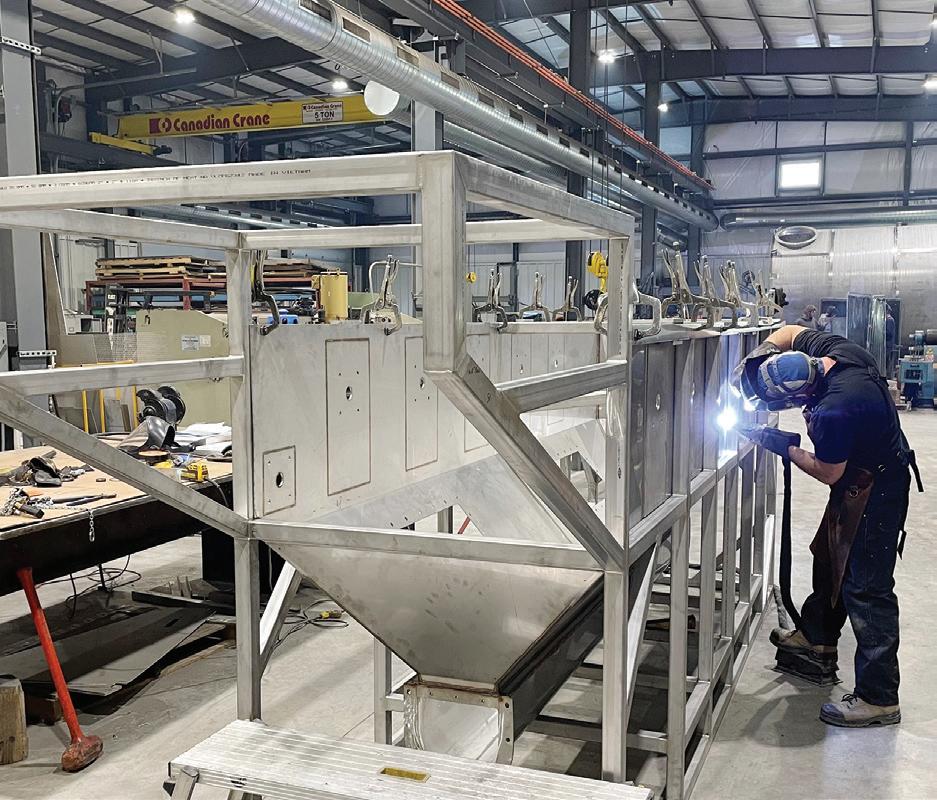
KINGSTON
What has been the biggest challenge you have faced in relation to the fast growth of your company?
Space and manpower. The biggest challenge was growing both without creating a “too big too fast” scenario.
What did you do to address it?
We moved into our newly constructed facility in early 2020, which provided a much better work environment and gave us some more room, which allowed the work to flow better through the shops. We added positions to complement the very capable group of existing employees. Retention of existing employees and finding the right people to fill new positions are both key factors in our success. With the right team, it is easier to diversify and break into new markets.
Be aware that you can grow too fast. While you need the ability to adapt to changing circumstances, it is important that we stay true to our core values and grow on our own terms. Every situation needs to be handled with integrity.


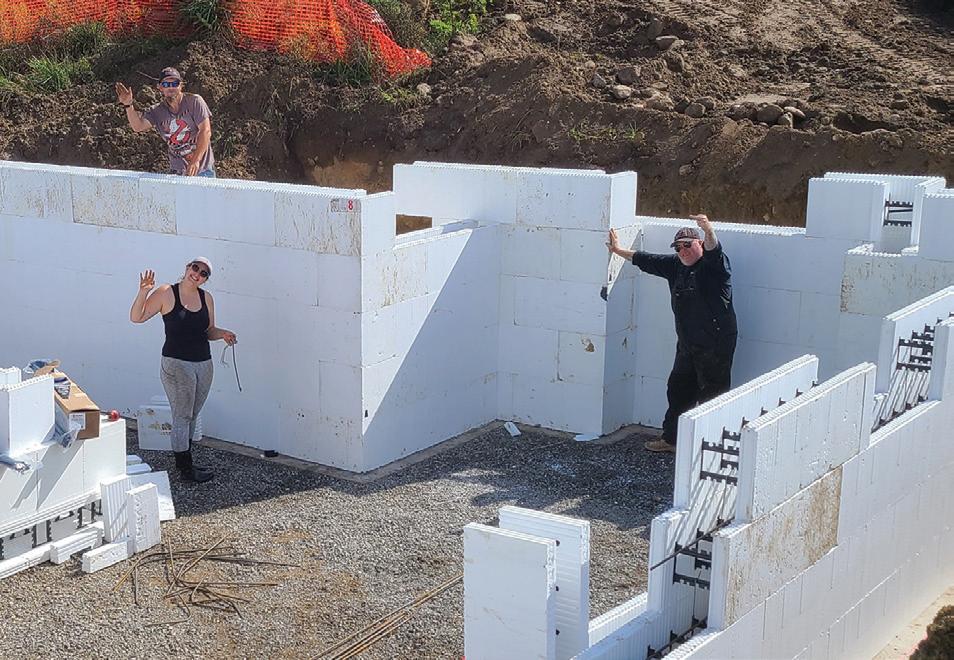
Marble Rock Developers & Construction specializes in restoring neglected residential properties, major additions and commercial renovations.
What has been the biggest challenge you have faced in relation to the fast growth of your company?
Finding the right partners and staff was the first big challenge. From suppliers to tradespeople to in-house staffing, finding and developing these relationships has made the biggest difference to our growth.
What did you do to address it?
We were diligent in sourcing partners and staff using agencies like Keys Job Centre, local suppliers and being willing to travel to source materials when we were faced with gaps in the market or supply chain.

What has been your biggest lesson learned? Our most important takeaway over the past three years has
been that there is no such thing as too much planning or flexibility. We spend an enormous amount of time planning for different scenarios in staffing, financing, supply chain and, of course, weather! With contingencies in place we are able to be nimble when changes occur.
HFI Pyrotechnics is a 149-year-old startup providing search and rescue flares around the world.
What has been the biggest challenge you have faced in relation to the fast growth of your company?
The biggest challenge HFI faced in doubling the company’s size was recruiting and retaining employees. From 2020 to 2021, HFI recruited, onboarded and trained more than 305 persons to fill 65 positions. This churn created chaos for the HR team through to the production floor; the introduction and exiting of
employees slowed production, introduced quality issues and left no time for a team’s ability to bond.
Our vision of “Together/Stronger” has been a simple and strong message that worked well during COVID-19 and continues to create a family-like environment. We tailored our recruitment ads, questionnaires and interviews to ensure we were clear about what we were and who we wanted. We created an intensive onboarding that exposed the new hires to all parts of our organization so they knew who we were and allowed our team to confirm new hires fit our expectations. We reworked our organizational structure to give employees a career path. Every step had expectations, titles and remuneration and was driven by the employee and their direct supervisor. We reworked our remuneration to be financially competitive. We emphasized the existence of the benefits and we increased our starting rates significantly.
We had to move fast and we had to be transparent with our employees. It had to be easy to explain and attractive to our employees and we had to keep the organization in the loop through the evolution to the new structure.
Wonton Crunch produces wontons of various flavours using a machine developed by the owners.

What has been the biggest challenge you have faced in relation to the fast growth of your company?
As the business grows, it is difficult to build new equipment. This is holding us back from growing even faster than we are currently.
What did you do to address it?
We are still looking to get financing but at this time we are trying to get new employees to start a second or even third shift.
What has been your biggest lesson learned?
I would say having the support of the community has a lot more merit than I ever imagined. Building a brand requires support from a very large circle, not just customers.
PRESENTED BYJPB Fabrication Services is a 24/7 turn-key industrial service provider specializing in ferrous and non-ferrous fabrication, machining, maintenance and custom design/ build.

What has been the biggest challenge you have faced in relation to the fast growth of your company?
Our biggest challenge is people — finding enough good employees to complete all the work we have been able to acquire. The employees that we have are very talented, however, we could definitely take on more jobs if we could hire more tradespeople.
What did you do to address it?
We have advertised on Canada Job Bank and various other recruiting sites. Also, networking with colleagues and on our website.
What has been your biggest lesson learned?
The biggest lesson I’ve learned is to believe in yourself when expanding the business. When I started out in a small garage with one employee, I couldn’t imagine we would ever get where we are today, but with courage, patience and a big vision we continue to grow.
Fab-Cut Systems is a CNC plasma table manufacturer, specializing in custom designed and engineered wood and plasma cutting CNC systems.
What has been the biggest challenge you have faced in relation to the fast growth of your company?
Supply chain and price increases have been our biggest hurdles next to employees catching COVID this year alone, which affected 17 of our 21 staff members.
What did you do to address it?
We had to expand our sourcing outside of North America and utilize the global supply chain network in order to complete the growing number of orders we were securing. This meant that we were able to offer other brands that were not the norm in North America. In some cases, this wasn’t well accepted by our current suppliers but it enabled us to supply new
CNC plasma cutting tables faster than most of our competitors.

What has been your biggest lesson learned? What we learned really quickly was that we needed to “diversify to stay afloat” and our team has come to understand how helpful that has become as our growth has reflected our successes in the past three years.
Le Boat is a luxury houseboat rental company operating on the UNESCO World Heritage Rideau Canal, from Kingston to Ottawa.

What has been the biggest challenge you have faced in relation to the fast growth of your company? Our biggest challenge hit us in March 2020 when all international borders were closed due to COVID-19 and the world went into shutdown and mass closures.
What did you do to address it? We had to pivot our marketing strategy and begin to market our tourism product as a great “staycation holiday” for those living in Ontario and Quebec and looking for a COVID-friendly travel option. We also increased our cleaning procedures, followed
all local health guidelines and obtained the Safe Travel Stamp.
What has been your biggest lesson learned?
Be agile, be flexible and have a good leadership team that is able to meet on a regular basis and be able to pivot global sales and marketing team strategies. Have great people in place and treat your customer the way you want to be treated, they will remain loyal and support you when the world opens up again!
Ontario East Regional Marketing Committee (RMC) The Regional Marketing Committee consists of Ontario East community members and economic development leaders who are actively involved in various investment attraction and Foreign Direct Investment (FDI) activities. In conjunction with Ontario East EDC staff, RMC members facilitate confidential investment enquiries and co-ordinate client calls for proposals, property, and other information, providing a seamless, single point of contact for potential investors.

From the borders of the sprawling GTA to the charms of small town Bobcaygeon and Alexandria; from the shores of Lake Ontario and the St. Lawrence River through breathtaking forests and fields, lakes and waterways of Haliburton and Ottawa Valley, to thriving urban centres like Kingston and Peterborough, the landscape of Ontario East is not only a spectacular place to visit and live, but also a burgeoning locale for innovative, diverse, and profitable economic development.
The mission of the Ontario East Economic Development Commission (Ontario East EDC)
for more than 30 years has been to let the world know about this relatively untapped jewel, located in the heart of the nation’s economic engine, between Toronto and Montreal. Comprised of economic development professionals from both upper and lower-tier municipalities throughout eastern Ontario, the Ontario East EDC has used its combined knowledge and expertise to leverage resources, share information, and promote the unique nature of Ontario East’s potential for growth, its market access, affordable business costs, excellent workforce, and more.
In a landscape that is a mix of rural and small to medium urban, the Ontario East EDC membership
has dedicated itself to showing the rest of the province, country, and the world, that Ontario East, is much more than it seems. Utilizing a comprehensive and forward-thinking strategy and the latest in virtual technology, Ontario East EDC officials are in constant contact with corporations and influencers around the globe, selling them on the virtues of the people, communities, and infrastructure of the region.
With a definitive focus on the key sectors of advanced manufacturing and technology, food and beverage, and logistics and transportation, the RMC uses its marketing effectiveness to extol the virtues of investors to make substantial investments to the region, with the ultimate goal of anchoring these wealth-generating employers in the Ontario East supply chain, improving the overall health of the regional economy, and the quality of life of all those who live here.
Representatives from the Ontario East EDC regularly attend various targeted trade shows and conferences, using these platforms for networking and investment attraction purposes. As well, for as long as it has been in existence, the organization has also hosted the annual Ontario East Municipal Conference (OEMC), bringing together municipal officials, suppliers, community development and economic development organizations, and provincial ministries, agencies, and others to share information and resources, make contacts and deliver a message that underlines the importance of collective co-operation for the enrichment of all in the region.

The numbers don’t lie. If larger scale enterprises make Ontario East their new home, anywhere from 20 to 200 local suppliers from throughout the entire region
will benefit as they contribute to ensure their smooth business operation. While one municipality may derive the direct benefit of this investment by playing host to it on the ground, businesses that fulfill the practical supply needs for the business attracted, regardless of where they are located in Ontario East, will also be rewarded with increased regular business.
On a practical level, the Ontario East EDC website https://www. ontarioeast.ca also features a real-time inventory of lands and buildings available for development within each municipality and will also facilitate discussion with the individual municipalities of interest to help find the most suitable properties and offering incentives to help sweeten the deal.
The Ontario East EDC offers a compelling and mutually beneficial message that continues to bear fruit, even during the challenges of recent times. Prospective investors and firms come to understand the benefits of Ontario East, most significantly the cost of doing businesses. Compared to larger urban centers, not only is
there much more available land, much of it already designated as ‘employment lands’ but it is less expensive. And being outside of these larger centers is not detrimental in terms of access to larger markets, as the Ontario East EDC enthusiastically promotes the extensive and efficient road and rail network, as well as access to and from New York state through four non-congested border crossings. There are also two deep-water seaports, one near Prescott and one just outside of Picton.
Another key aspect of the messaging being broadcast by the Ontario East EDC is about the workforce within the region. Research has shown that residents in the various Ontario East communities are more likely to stay within their communities and their employers, as they tend to put a premium on their pace and quality of life. Ontario East has seen an influx of individuals and families moving into the region from large urban areas because of both the lower cost of living, and the generally more placid pace of life.
The employees and entrepreneurs of the future in Ontario East are also blessed with world-class post-secondary institutions, where they can acquire the knowledge and skills needed to ensure recruiters for the larger companies don’t have to cast their nets wide to seek qualified workers. Other students will be inspired to use their talents to open their own businesses, ones that could be plugged into the broader and growing regional supply chain, buttressing the regional economy even further.
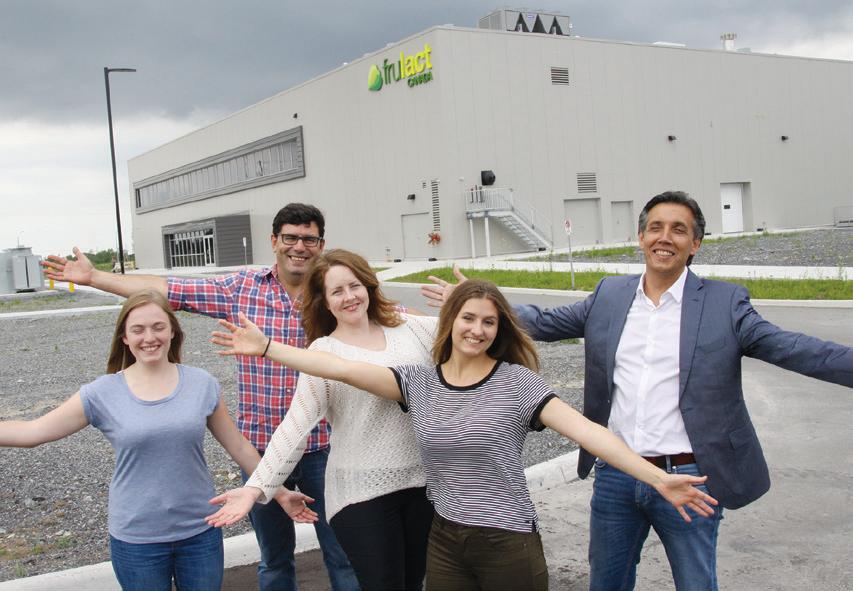
Schools such as Trent University, Queen’s University, Fleming College, Loyalist College, and St. Lawrence College have developed programs attuned to the needs of the 21st century interconnected global economy and provide opportunities for students in eastern Ontario to study closer to home, and closer to the local job market.
With the ever-changing nature of the global economy, the Ontario East EDC has consistently been able to pivot and adapt to meet the challenging new


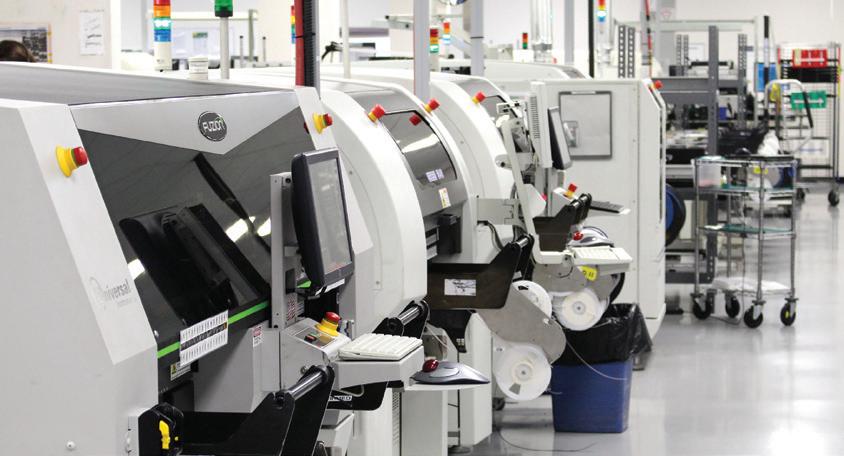

circumstances, with the ultimate goal always being to generate significant investment into the communities that comprise Ontario East. What does not change, are the measurable advantages of location, cost and workforce consistency and viability that are the hallmarks of eastern Ontario.

What also remains firm is the Ontario East Economic Development Commission’s mandate and dedication to supporting workforce development through investment attraction and retention for both new and existing employers, and also supporting our municipal partners in their various individual business development endeavours.
Discover the Ontario East advantage today by visiting ontarioeast.ca

Since its founding more than 75 years ago, the Business Development Bank of Canada (BDC) has remained a trusted advisor for Canadian businesses – especially when they need it the most.
That’s why BDC kept doing what it does best throughout the pandemic: lending funds to growing businesses, giving them a sound strategy for structured growth, and helping them implement that plan.
For YSB Carpentry and YSB Hoist, two family-owned businesses founded by brothers Yvan & Stephane Bourdeau in nearby Navan, Ontario, their expertise couldn’t have come at a better time.
YSB’s general manager Brigitte Benoit — who has performed “every single role you can imagine” at the company — came to rely on BDC to fulfill her current role: business development.
YSB was approached about acquiring the equipment from a Toronto-based hoist business that was shutting its doors — by hoists we mean the external elevators used to construct high rise buildings. They checked it out and recognized

a great business opportunity.
To purchase the hoists, they started working with BDC. With their business mentor from BDC Advisory Services, YSB was now equipped to go through its business structure and determine the best way to support the growth, which included bringing on key people.
“Because it was a new division, we needed the help from BDC to support the upswing in business,” said Benoit. “We’ve stuck with them because the sessions we have with our business mentor, like mapping out a strategic plan for structured, sustainable growth and then implementing the plan, were so invaluable.”
Together, YSB and BDC took a hard look at what was working within the company – but also what wasn’t working. It quickly became clear that to sustain YSB’s expansion, they would need more space.
BDC is now helping finance a new 14,000 square foot building to house YSB’s entire outfit, which will break ground this fall in Russell, Ontario.
“BDC’s mandate is to help as many businesses as possible,” said
Hugues Boulerice, Senior Account Manager at BDC. “At the end of the day, we’re here to support entrepreneurs’ growth, that’s our main goal.”
In addition to their entrepreneurcentric approach, BDC also offers a range of flexible solutions to help them through the ups and downs of the business cycle. “If we’re lending money, it’s for growth and it needs to happen,” said Boulerice.
BDC works shoulder to shoulder with the businesses they support. Unlike firms who would charge businesses $25,000 to give them a strategy with an encouraging pat on the back, BDC sticks around during the implementation phase. They help businesses work smarter and avoid the pitfalls of growing too fast.
“YSB is a perfect example of a fast-growing company with a ton of
potential and they’re good at what they do,” said Boulerice. “They just needed a little bit of help.”
Many family-owned businesses benefit from taking a more proactive approach to accounting so they can get a real-time snapshot of how their business is performing during the growth stage. “It’s hard to be proactive when your accounting reporting is three months behind,” said Boulerice.
Benoit says other businesses could also benefit from the type of support she’s received at YSB. “I’ve dealt with so many different banks and I’ve never encountered this type of support. You feel like you have a partnership with a mutual goal,” she said.
“I’ll put it this way. I don’t always need to go to BDC, but because of the relationship, I choose to.”
The Business Development Bank of Canada offers financing with a side of sound advice— SPONSORED CONTENT —
“One of the biggest challenges was that we weren’t able to offer samples anymore and do the trade shows,” she recalls. This was a problem since sampling was key to Zengarry’s marketing in the crowded world of vegan cheeses where not all products are created equal, she explains.
Needing a fast solution, Turner decided to launch an online store, something she hadn’t focused on before. Here she ran into the next big challenge: how to ship a perishable product in a way that meshed with her eco-philosophy.
“It’s a bit of a hassle with a product that needs refrigeration to be shipping and overnight shipping can be expensive and not everyone is willing to absorb that cost,” says Turner. She also didn’t want to use styrofoam shipping containers, eventually finding recyclable carboard insulated packaging. Today, her shipping is limited to Ontario and Quebec because of the prohibitive cost of overnight shipping across the country.
Over the past two years, Turner has become more comfortable in the online marketplace, even reaching out to online influencers.
A 2018 study out of Dalhousie University shows that 63 per cent of vegans in Canada are educated and under the age of 38. They make up more than 10 per cent of the Canadian population — an estimated 6.4 million Canadians.
Certainly, vegan options are now available in most mainstream grocery chains and no longer relegated to health food stores.
“That was one thing that motivated me a lot,” says Turner. “I felt like if plant-based food was more readily available, then more people would make that choice, not just because it’s better for the animals, it’s better for your health, it’s better for the planet and you know there’s so many reasons why.”
But it seems Turner has not left her bureaucratic days completely in the past. The whole vegan food marketplace is shaking up the food industry and raising questions about what to call plant-based food substitutes.
“It’s an ongoing topic,” Turner admits. “The dairy industry has claimed the words cheese, milk and butter and they don’t want plant-based companies using those product names. So (the dairy industry is) poking the Canadian Food Inspection Agency to challenge these companies on using those words.”
The issue first came onto Turner’s radar in 2015.
I
n 2010, Lynda Turner decided to transition from a vegetarian to a vegan diet. Only problem was, she particularly missed cheese.
As a result, Turner began experimenting with plant-based meals in her kitchen and it wasn’t long before she turned her focus to cheese substitutes. As an ecotoxicologist at Health Canada for almost 20 years, Turner knew how plant-based eating could drastically reduce climate change.
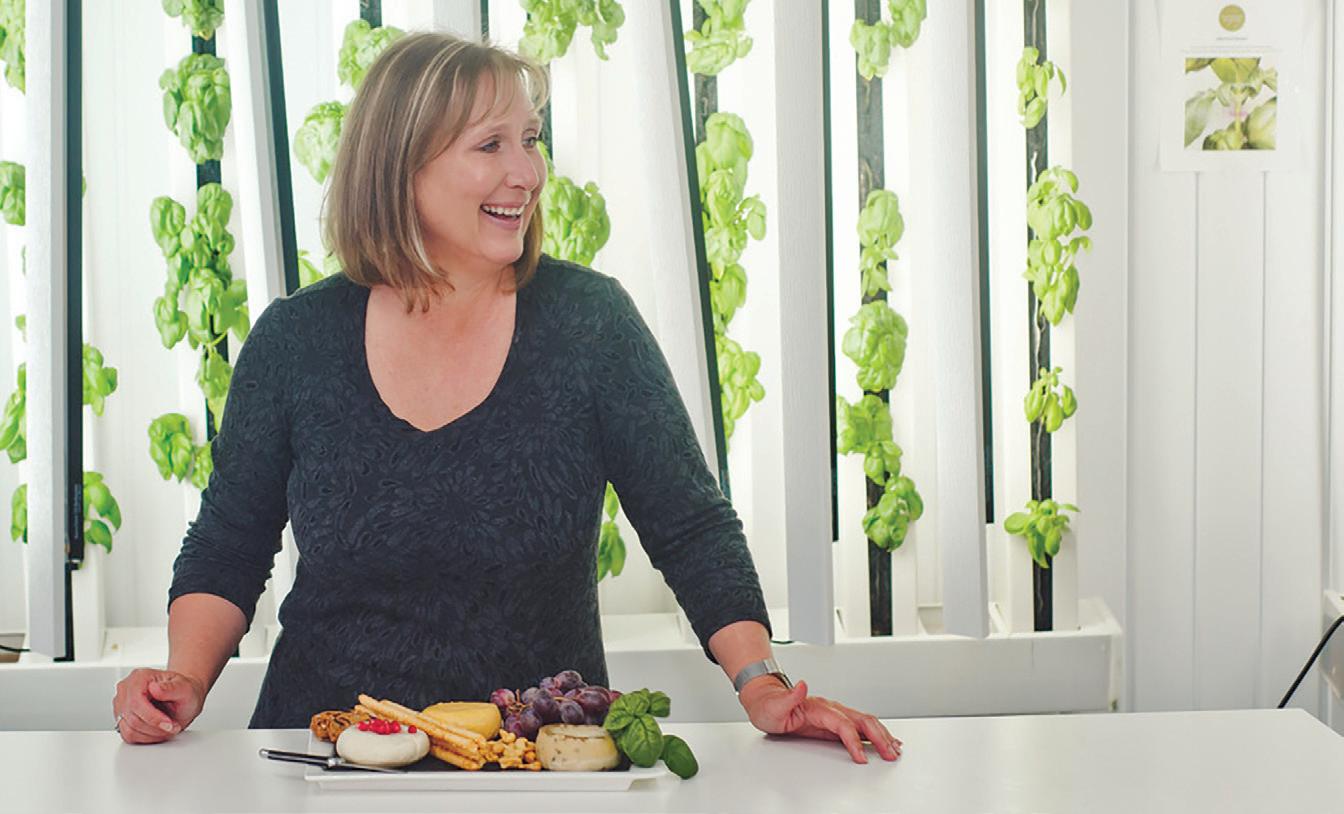
Her strong beliefs prompted her to leave her government job to prove that eating plant-based food could be both simple and satisfying. By 2013, her parttime experiments making cashew cheese had blossomed into her own company, Fauxmagerie Zengarry, a name that recognizes not only her zen outlook on life but also her home in Alexandria in the township of North Glengarry.
Cashews are rich in nutrients and high
in heart-healthy fats. Turner’s recipe was to soak them in water and whip them into a rich and creamy texture to which she added all-natural ingredients, fresh herbs and custom probiotics before aging them to perfection.
In 2016, the company moved into its first commercial kitchen, opened a vegan cheese shop in Alexandria, and started growing herbs in-house on “living walls.”

A year later, a new brand identity was introduced, emphasizing eco-friendly packaging and responsibly sourced ingredients. That same year, the company’s product was voted one of the top 10 most innovative at the Grocery Innovation Canada show. In 2018, Turner was selected as one of the “8 Women Changing the World for Animals Through Food” by the Unbound Project. By 2019, the company had moved into a new commercial building that tripled the size of the previous facility.
Then, in 2020, the pandemic pulled the rug out from under Turner’s feet.
“We send them product, educate them on it and are developing this team of Zen-bassadors and working with them to create content that we can also use on our other platforms,” says Turner. “Also, paid influencer advertisers is something that’s really taking the forefront in the social media marketing space right now.”
Almost 10 years after its founding, Zengarry now occupies a 5,000-squarefoot manufacturing plant in Alexandria where Turner and her team process cashews into cheese. Looking to the next evolution of her business, Turner is seeking other companies in need of a manufacturing facility.
“We are looking to bring some other brands and do manufacturing in our facility … We would just do the manufacturing, then they would package as they have been packaging and then ship it out as their own product – it’s called co-packaging,” says Turner.
While there have been some twists and turns for Turner, it seems certain that she has found a lucrative and growing niche market. Figures for the global vegan food market put the overall value somewhere between US$17 billion and US$24.3 billion in 2020. Almost all the available research suggests that the market is growing fast.
“At that time, the CFIA allowed us to use the words ‘100 per cent dairy free cashew cheese’, in that order. So we could use that or move away from using the word cheese, because who knows what they’re going to decide next month or next year and changing our packaging is not a small investment,” says Turner, who has rebranded twice, at a cost of about $10,000 each time.
“The Government of Canada is aware of changes in the marketplace and recognizes the importance of clear guidance on how to label, sell, advertise and package these foods in a manner that is truthful,” the CFIA explains.
The CFIA says it has completed a public consultation to get feedback on proposed guidelines for simulated meat and poultry products and has received requests for clarification for plant-based dairy and egg alternatives.
“These comments have informed our plan for a next round of consultation that is scheduled for fall/winter 2022,” the agency says.
Stephen Burnett thinks he has a strategy that will bring an influx of tourists to hard-hit communities along the St. Lawrence River by inviting cruise ships to send passengers ashore to engage with local attractions and businesses.

Burnett, executive director of the Great Lakes Cruise Association and himself a mariner, has spent the past 21 years focused on reactivating the river and the Great Lakes cruise industry. Because of recent advances in cruise ship navigation and technology, what was once impossible could now potentially be a viable part of
southeastern Ontario’s economic recovery post-pandemic.
“Living in the region allows me to provide a first-person account of what the St. Lawrence has to offer,” says Burnett. “This allows me to present the region with passion, knowledge and vision.”
The St. Lawrence has historically been a route for smaller U.S.-based cruise ship operators touring overnight passengers from the Atlantic coast through to the Great Lakes. Although passengers are able to see smaller towns and cities as they pass by, there was no option to disembark because very few southeastern Ontario communities have the necessary marine port infrastructure to accommodate cruise ship docking.
Lawyers Commercial Litigation
support your business through any dispute – be

with velvet glove or iron
“There are communities that don’t have ports and they can’t afford ports and they shouldn’t be spending hard-earned money on building ports,” said Burnett. Still, he believes these communities have a tremendous amount to offer travelers who want to do more than just observe the scenery on their way by.
Cruise operators, responding to a growing demand for more active and engaged tourism experiences, have launched more nimble cruise ships able to pilot to smaller communities and offthe-beaten-path destinations. Dynamic position technology allows these cruise ships to “park” offshore, without using anchors, and safely launch smaller watercraft, or tenders, to shuttle passengers to shore and back without the need for a port. This is a game-changer for smaller communities along the St. Lawrence and in the Great Lakes region.
“People could go ashore using the tenders on the ship and visit the community and do nature-based activities such as hiking, biking, canoeing, kayaking, touring and meeting the community,” says Burnett.
Expedition cruising is currently offered in various locations from Alaska to Antarctica and tends to attract a curious and more physically active crowd. Because of the smaller passenger capacity of the ships, operators look to develop unique and immersive on-shore programs and excursions.
This includes the opportunity to actively engage with local communities
and their history, people, food and culture and make deeper connections to each locale. On the flip side, it creates economic opportunities for communities to showcase their products and services to an entirely new and, in the case of the cruise industry, untapped market.
Of particular importance to Burnett and the GLCA is creating new opportunities for Indigenous communities to engage and participate. This commitment to empowering Indigenous tourism by making the communities more accessible is something that appeals to Bonnie Ruddock, executive director of RTO 9, a provincially funded regional tourism organization based in Kingston.
“We’ve been working with Indigenous Tourism Ontario for the last year and a half to work with their operators on building more opportunities within southeastern Ontario,” says Ruddock. “So when Stephen approached us about cruising in this part of the region, definitely it’s something we’re interested in as well.”
For now, the Port of Johnstown remains the sole cruise stop along the southeastern Ontario stretch of the St. Lawrence. Looking ahead, Burnett remains optimistic and committed to his plan.
“I have spoken to each of the cruise lines heading this way and there is definite interest in what the region will have to offer for future cruise visits,” he says. “I don’t think we have an insurmountable challenge in persuading the cruise line operators to include more of the St. Lawrence.”


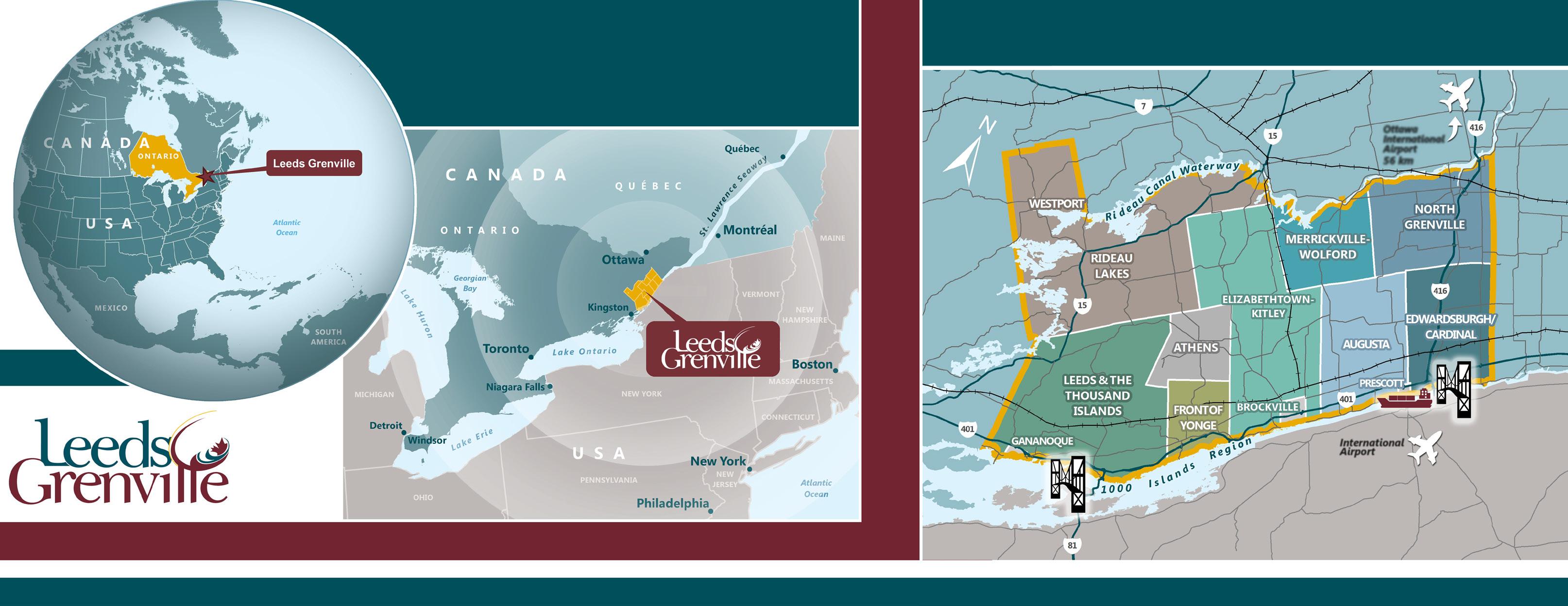

Living in the Ottawa Valley is the life-changing opportunity you’ve been looking for. Live and work in an inspirational environment with a limitless backyard at a very affordable cost of living.
Commercial real estate and manufacturing investors will find growing municipalities, rapidly expanding multi-lane highways and a broad range of properties and business opportunities.
Come for a visit to see and experience what Renfrew County has to offer. Whether starting, buying or investing in a new business or career, Renfrew County offers a balanced approach where you can live rural and work global. Find out more at InvestRenfrewCounty.com



